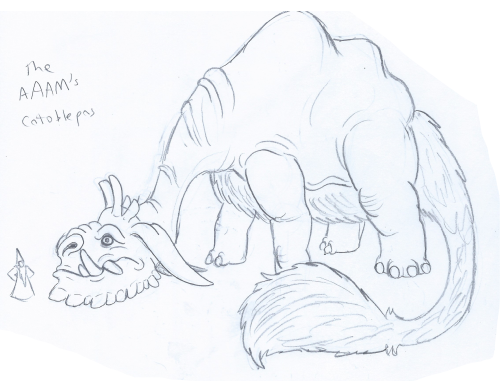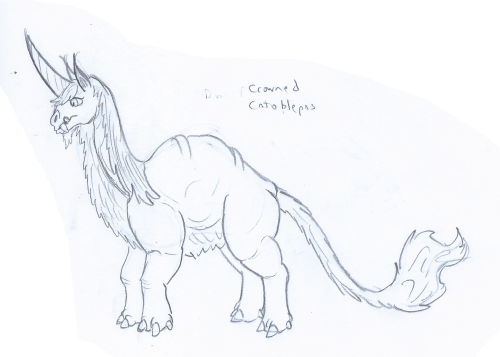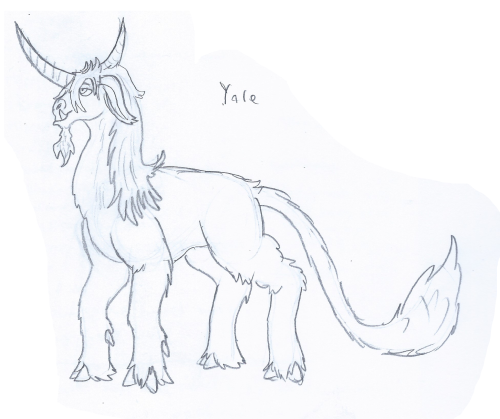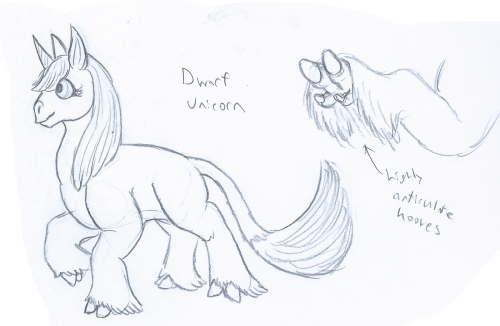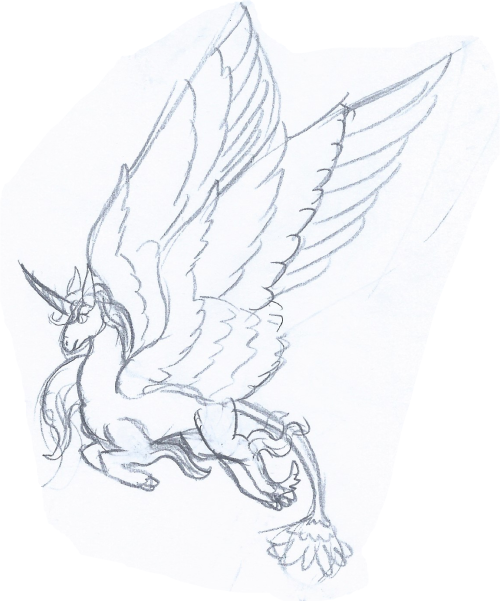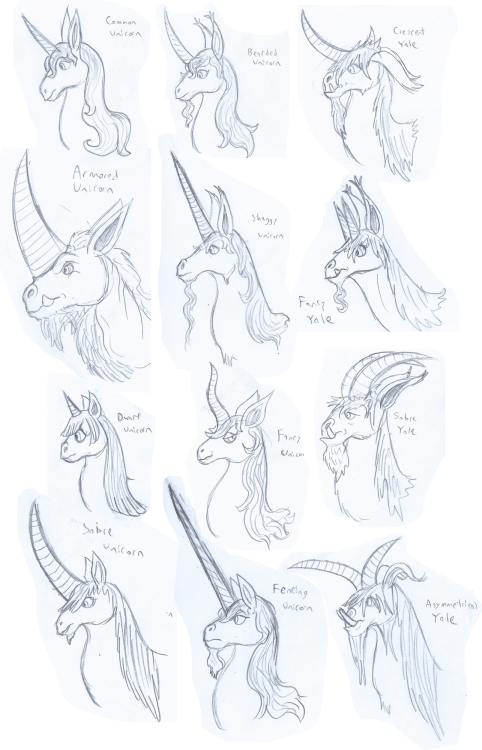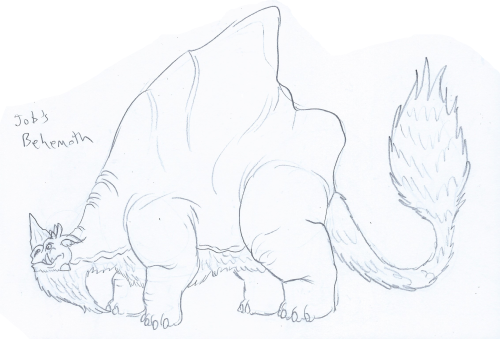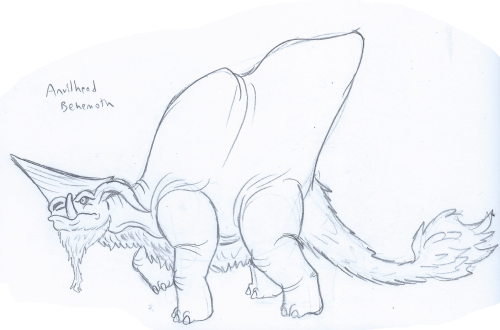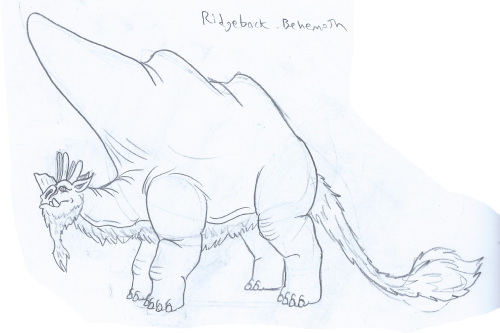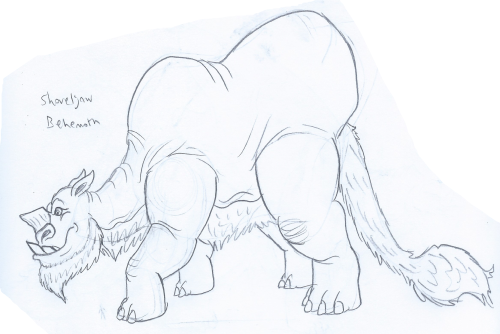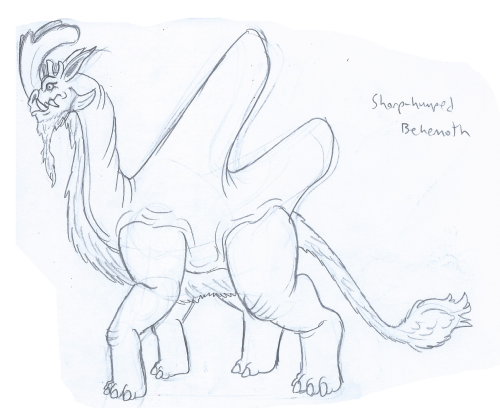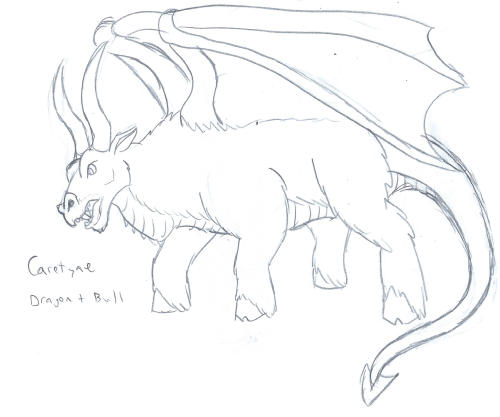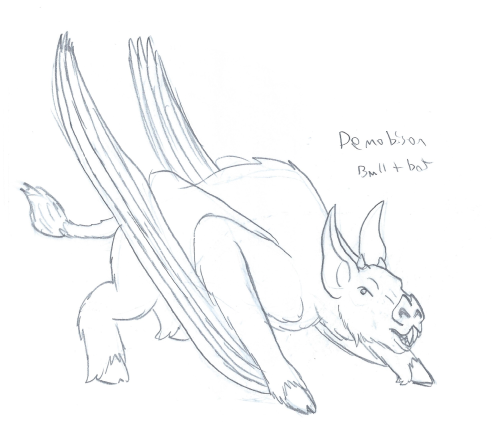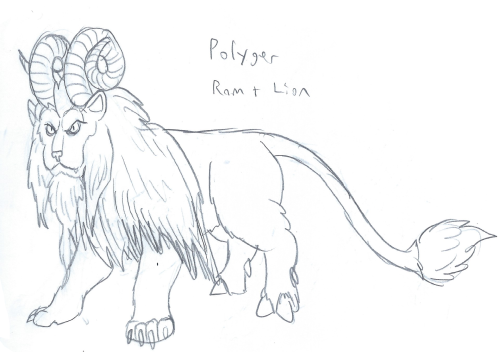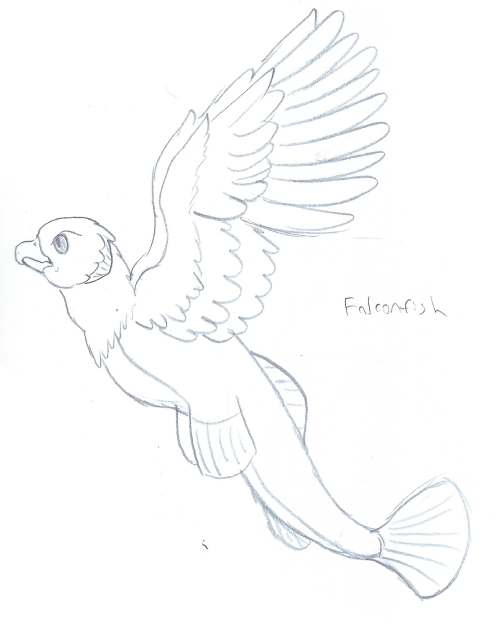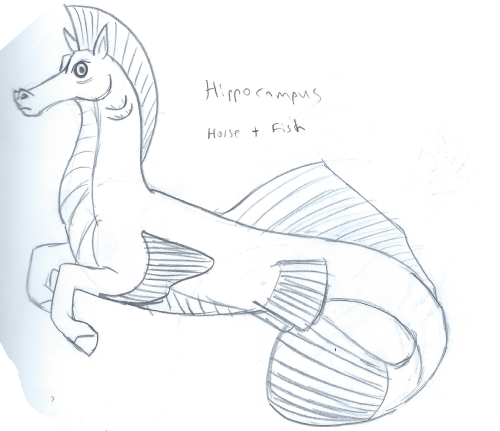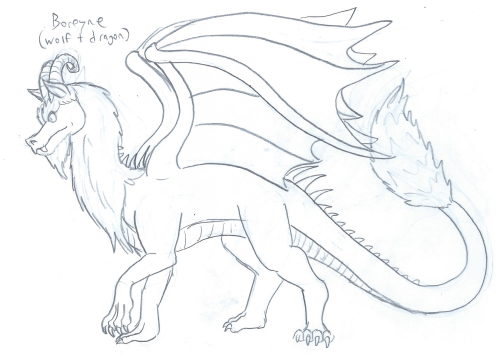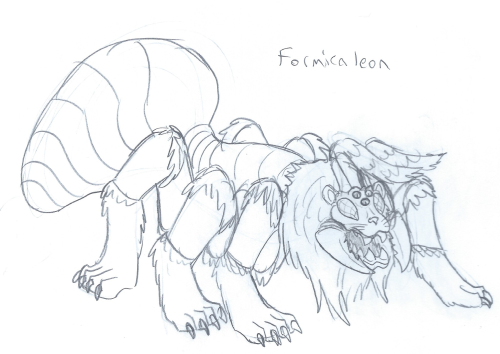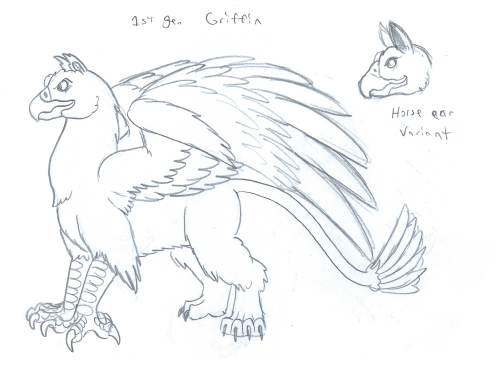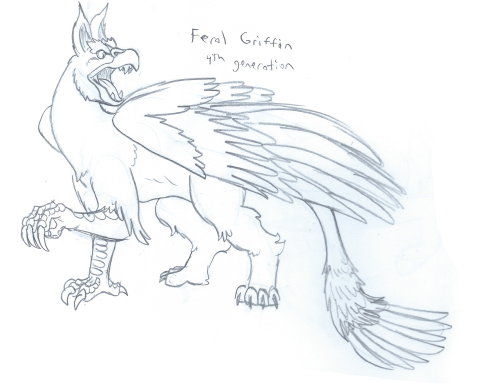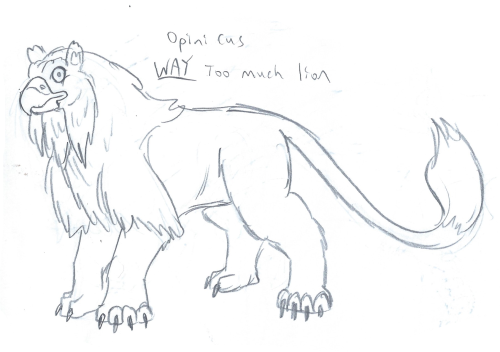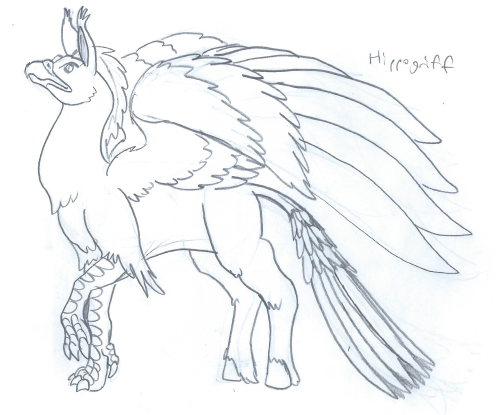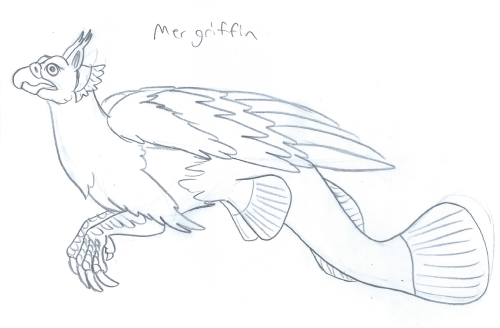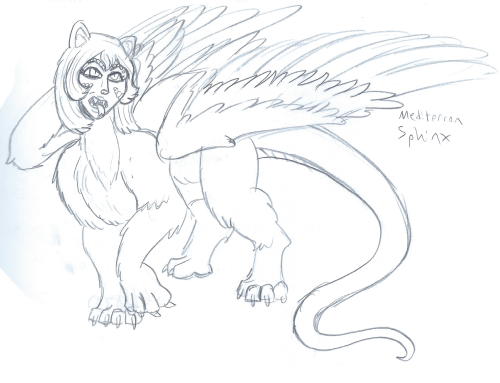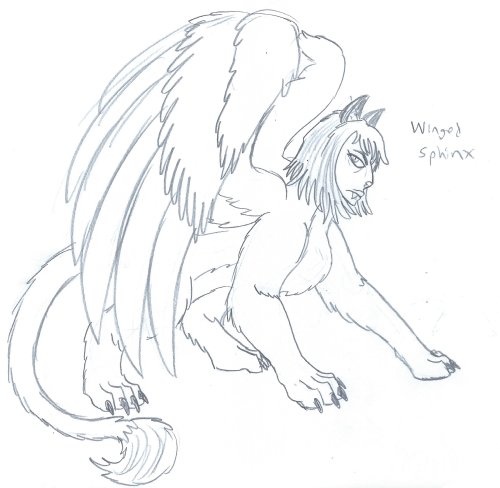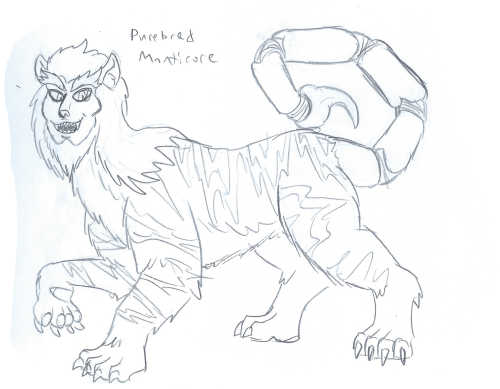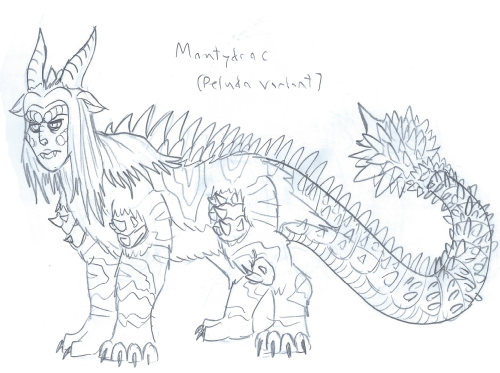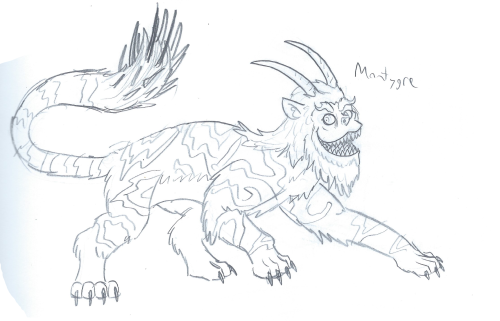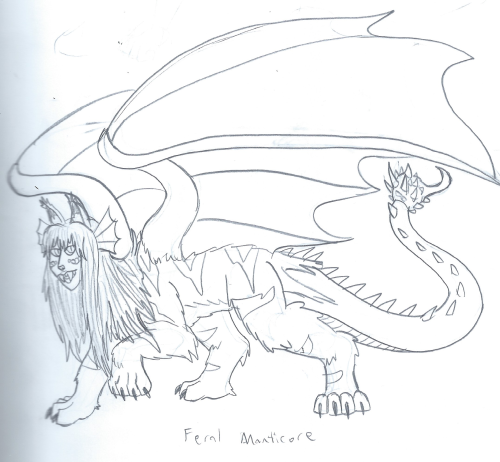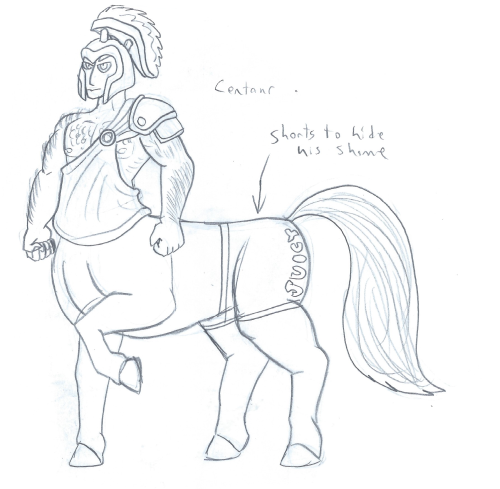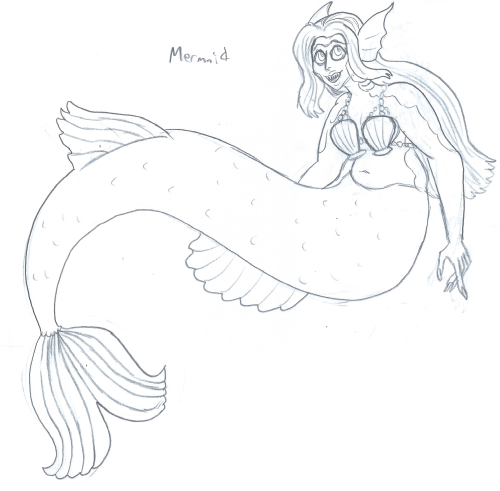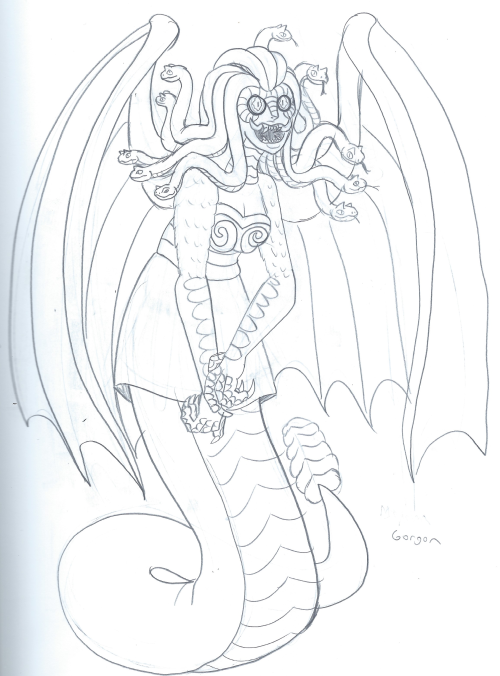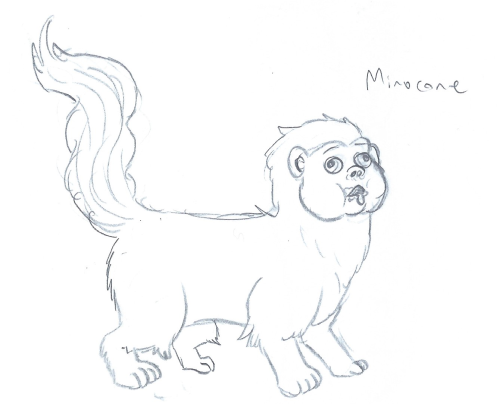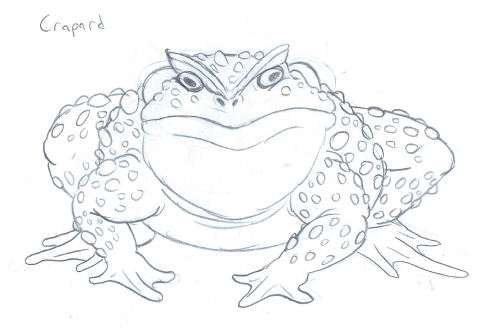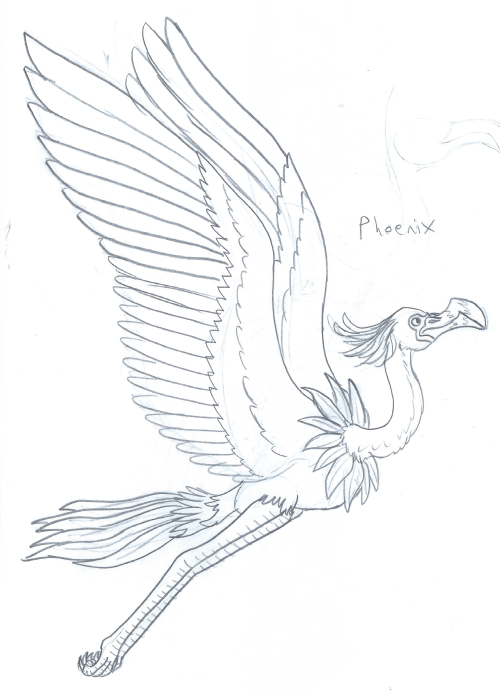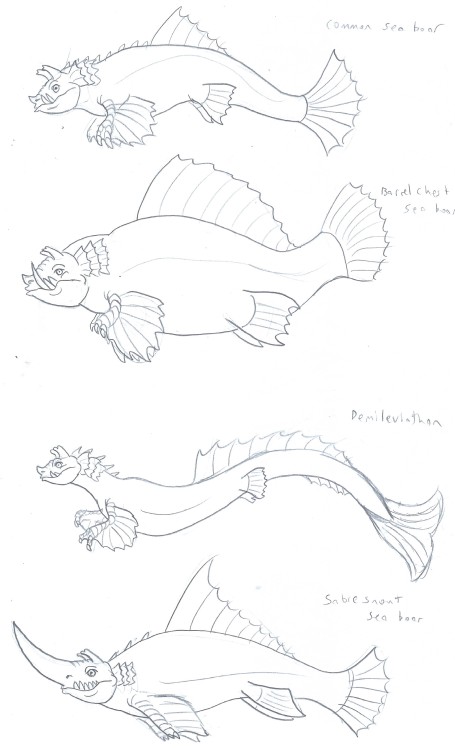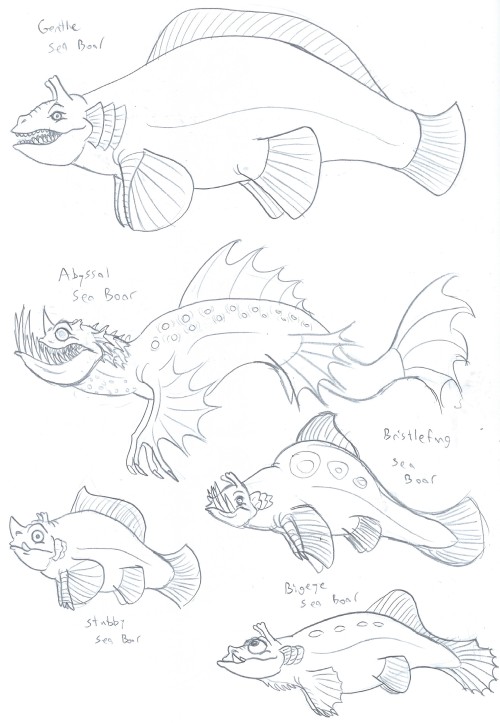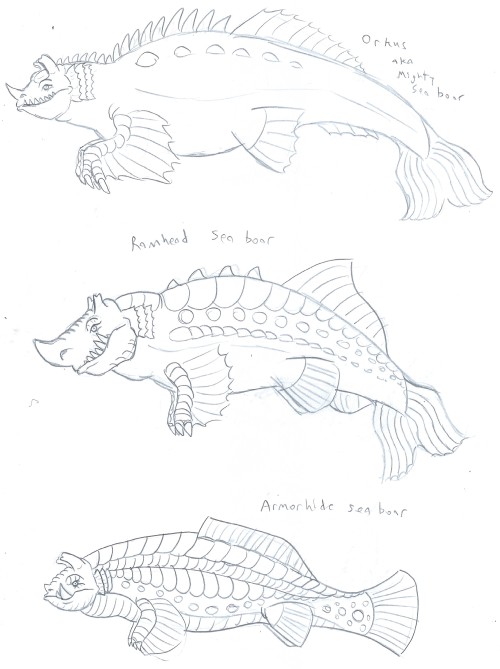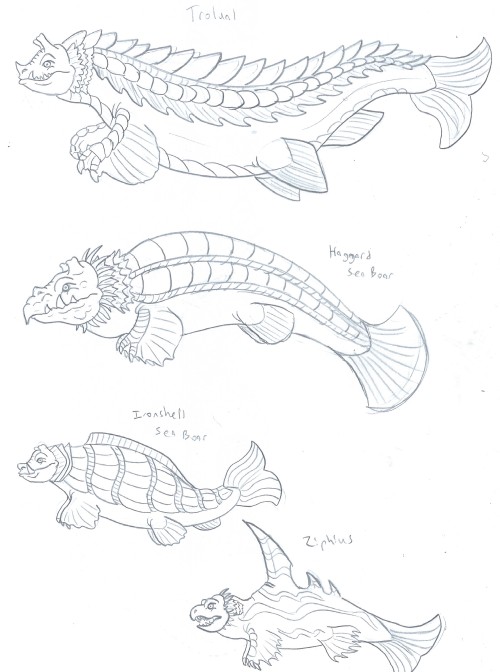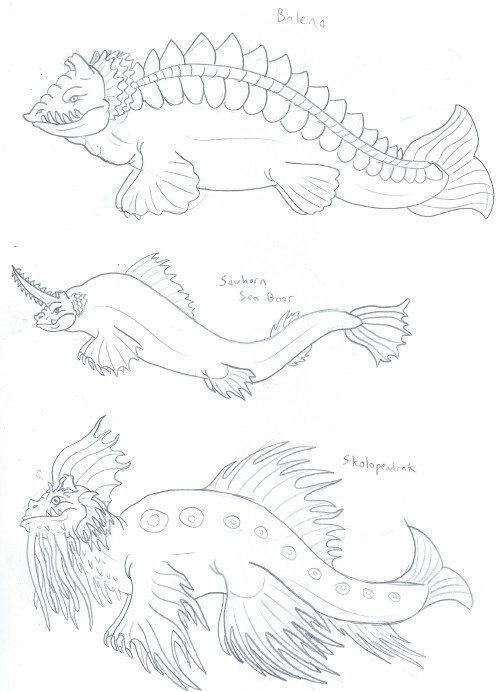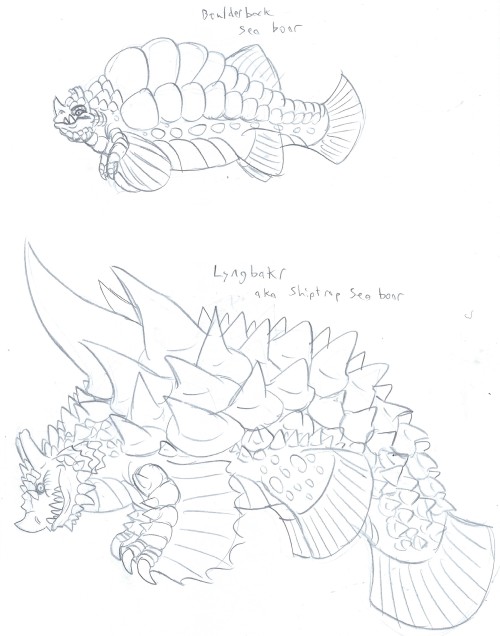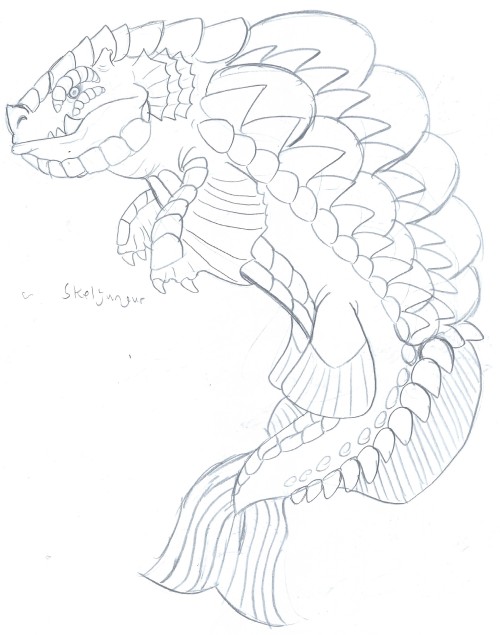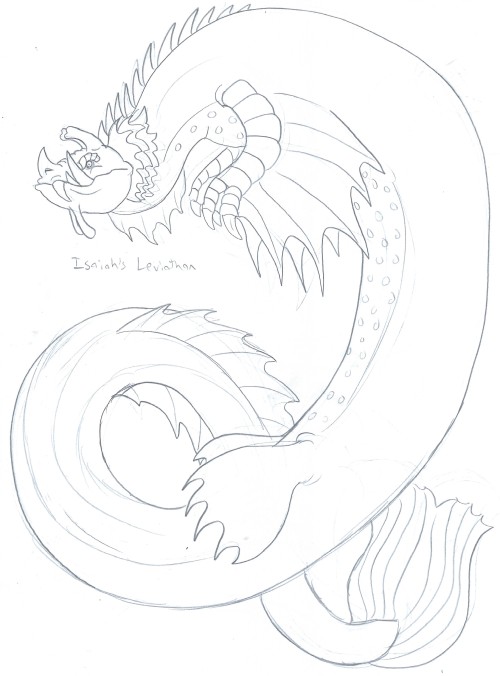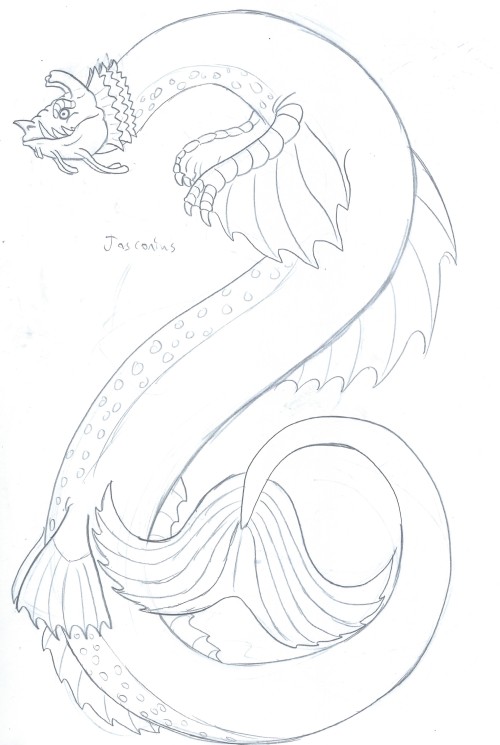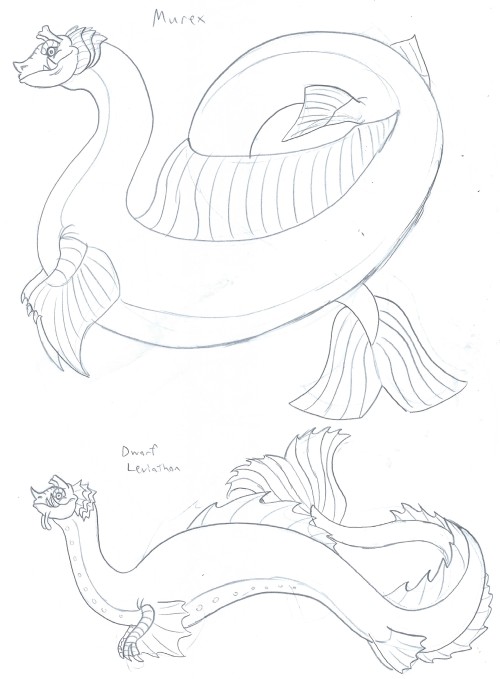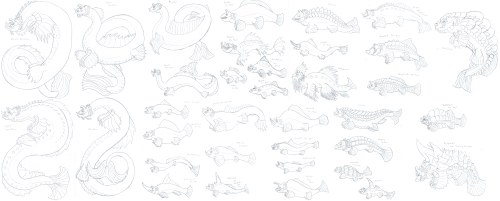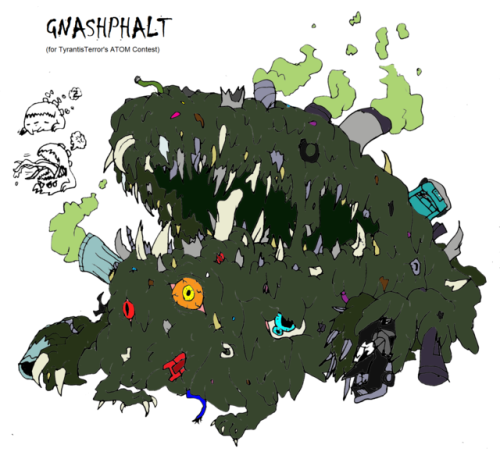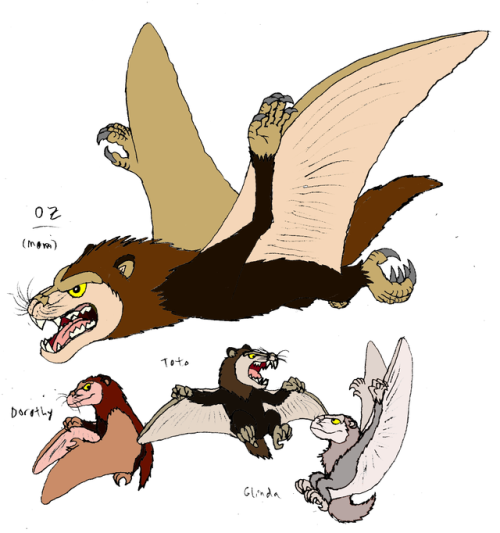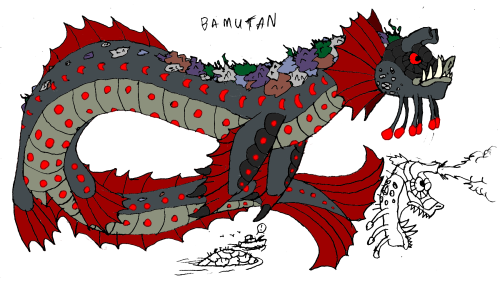#tyrantisterror
Drew some weird horses today.
The Wild Catoblepas: one of the smallest species of behemoth on Midgaheim, this omnivorous giant is nigh invulnerable to most conventional and magic forms of attack.
The Domesticated Catoblepas: After centuries of inbreeding by human wizards, domesticated catoblepases barely resemble their wild relatives. Their enlarged heads and weakened necks make them utterly reliant on humans for survival, and humans in turn harvest the valuable alicorn that makes up their horns, as well as their armored skin and magic-resistant wool.
The Crowned Catoblepas: the smallest species of behemoth on Midgaheim, this elephant-sized mammal is still more than capable of trampling a human to death without breaking a sweat, though it’s more likely to gore them with its enormous alicorn horn.
The Armored Unicorn: a rare variety of unicorn, this heavily armored mammal is larger than a mundane oxen and even more cantankerous.
The Yale: aka the centicore or false unicorn, this beast’s two alicorn horns are somewhat articulate, able to twist around in their sockets.
The (Un)Common Unicorn: despite common descriptions, this beast more resembles a deer than a horse, though neither are really its close kin. Intensely magical despite their small size, these creatures are much sought after for their miraculous powers and incredible beauty. Whether they are truly scarce in number or simply extremely good at avoiding humans is a matter of some debate.
The Dwarf Unicorn: not much larger than a domesticated goat, this unicorn’s small size is deceiving, as it is no less magical than its larger brethren. Intensely intelligent and curious by nature, this unicorn’s front hooves have special digits to allow them to work as grasping appendages, which these unicorns have often used to pick the pockets of unaware humans. They are sometimes erroneously called “fairy unicorns” despite not hailing from Fairyland.
The Pegasus: a chimera made of horse and bird components (generally eagle), these creatures have often been bred for use as flying mounts, despite their intensely aggressive natures.
The Pegacorn: even though pegasi are already extremely ill-tempered and prone to throwing riders to their deaths when incensed, some humans decided they weren’t special enough and decided to make the same chimera with a unicorn in place of the horse. The resulting mix is an extremely dangerous creature, as the high magic power and inherent shyness of the unicorn is combined with the aggressive territoriality of the bird, resulting in a horribly powerful beast that really doesn’t care for humans trying to ride on it.
Post link
Extrapolating from what I posted yesterday, I drew a bunch of unicorns and yales, because unicorns are a big fantasy creature and deserve at least a fraction of the attention I lavish on dragons and basilisks and whatnot.
Post link
Going off of what I posted yesterday, here’s some big ol’ behemoths for your enjoyment.
Job’s Behemoth: The oldest known species of Behemoth, which traveled to Midgaheim from a continent to the South East by a land bridge that no longer exists. The largest of its clade, this titanic mammal is often mistaken for a mountain range during its century-long naps. When awake, a Job’s Behemoth immediately goes on an eating binge, which can be likened to a natural disaster for any living thing in its path.
Midgaheim Behemoth: Second only to Job’s Behemoth in size, this titanic brute’s omnivorous appetite is slightly less catastrophic than its ancestor’s thanks to its shorter hibernation cycle and more picky eating habits. Though all behemoths produce dung that works as a powerful fertilizer, the Midgaheim Behemoth’s is by far the most effective. As a result, just as many ecosystems owe their existence to these beasts as those that were ravaged by them.
Anvilhead Behemoth: Given that behemoths are often preyed upon by dragons, ogres, and other large predators in Midgaheim, it’s only natural some developed defenses against them. The Anvilhead Behemoth’s alicorn nasal horn is large and wide enough to shield its head and neck from dragonfire, protecting it from the many dragons that would gladly make a meal of it.
Longhorn Behemoth: Though on the small side of the behemoth family, this behemoth is one of the most deadly, as its goring horn, strong neck, powerful legs, and hair-trigger temper make it a terrifying adversary.
Ridgeback Behemoth: One of the most peaceful behemoth species, the Ridgeback’s diet is primarily vegetarian, with only rare indulgences in eating meat.
Shoveljaw Behemoth: A truly gluttonous creature, the Shoveljaw Behemoth is completely careless in what it consumes, uprooting vast quantities of earth with every bite as it hastily tries to get the maximum amount of matter in its maw.
Wartusk Behemoth: Though useful in fending off enemies and slaying large prey, the enormous tusks of the Wartusk Behemoth are more often than not used in mating competitions.
Naithair: A species of Behemoth adapted for cold environments like the taigas and tundras of Germanor and Ruslovak, the Naithair’s body is covered in thick wool and bristles, which not only insulated its body, but stab and sting into anything that may try to prey on them.
Odontotyrannus: One of the smallest Behemoths is also one of the most dangerous. The Odontotyrannus is almost purely carnivorous, and most disturbingly, seems to prefer human-sized prey most of all. With a mouth fills with long, needle-like teeth and a prehensile tongue designed to root into caves, burrows, and more recently, man-made buildings, these monstrous beasts can wipe out entire village populations while leaving the structures in tact, creating eerie ghost towns in their wake.
Sharp-Humped Behemoth: The most lithe and graceful its kind, the Sharp-Humped Behemoth is considered by many to be an elegant and awe-inspiring sight, and stories of the beast often focus on its majesty and grandeur while down-playing the fact that it’s just as likely to flatten any creature in its path as the rest of its kin.
Post link
A whole slew of chimeras for your perusal today!
Caretyne: bull + dragon
Demobison: bull + bat
Apres: bull + bear
Chatloup:cat + wolf + goat
Polyger: lion + ram
Falconfish:guess
Seadog: dog + fish
Hippocampus: horse + fish
Stellione: weasel + lizard
Boreyne: wolf + dragon
Post link
A few more chimeras for you! And a cautionary tale:
Mermecoleon: an infamous failed chimera - in this case, the result of a wizard trying to combine two animals that are vastly different and not having the skill to properly meld them. Mermecoleons are spoken of often by those who make chimeras, a hard lesson in knowing your limits. Though the original mermecoleon was incapable of eating, subsequent attempts have occasionally produced ones that are cohesive enough to at least live long enough to reproduce, and they lay enough eggs to actually last a long while as an obnoxious pest before falling apart thanks to their own ill-made bodies.
Formicaleon: of course, the idea that something is impossible has never been a deterrent to wizards, and eventually one did figure out a way to hybridize ants and lions into a functional chimera. Formicaleons are formidable monsters, combining the tenacity and family dynamics of both species to create powerful and territorial hunters that are more than capable of defending a wizard’s tower with extreme ferocity.
Botched Chimeras: any chimera can become a hideous, misshapen abomination if the wizard making it is careless and/or unskilled enough. Most botched chimeras fall apart shortly after their creation, though some manage to cling to life until someone or something finally ends their freakish misery.
Post link
GRIFFINS!
The most common chimera on Midgaheim by a wide margin, griffins have been made so often that feral populations are enormous and, by this point, just as critical to the environment as the many “natural” arcane creatures. Combining a lion (the king of beasts) and an eagle (the king of birds) gives griffins an affinity for both earth and wind magic - and, like other beasts who are attuned to two opposing elements of magic, this makes griffins incredibly powerful. Add to this the fact that they are not particularly hard to make, griffins are in many respects an ideal chimera - one needn’t be a master to create one, and yet they produce marvelous results.
This, of course, has led SEVERAL wizards to make griffins over the years, and in time those griffins reproduced naturally, to the point that many environments in Midgaheim now have large griffin flocks as a vital part of their ecosystem. After a few generations of interbreeding, the lion and eagle features in griffins become less distinct, with “feral” griffins often looking a bit more monstrous/wild than their sleek forebears.
Of course, some wizards still get it wrong, with the most common mistake being the use of too little eagle in the mix, resulting in chimeras like the Opinicus(lion with an eagle’s head) or the Keythong(i.e. a wingless griffin).
Likewise, wizards who are more skilled with chimera-crafting have sometimes felt the need to mess with the griffin recipe. Substituting different felines and/or raptors is common, as is adding just a dash of horse to make griffins that are more inclined to serve as mounts. Some take it a step farther and add a LOT of horse, creating Hippogriffs, which trade some ferocity for a more amiable beast. Of course, not all these twists are successful, as the scarcity of Mergriffins can attest to.
Post link
Bicorns, aka Sphinxes and Manticores
Mediterran Sphinx - one of the first chimeras ever created, the original sphinx was crafted by the monster progenitors Typhon and Echidna, themselves two of the most supremely powerful chimeras ever crafted. A lion with the head of a human woman, the wings of an eagle, and the tail of a serpent, this chimera combined the vicious killing power with flight, venom, and a devious human intellect. Though tricky to create, its power as both a guardian beast and a dauntless assassin/hunter made it much desired, and sure enough, wizards set out to replicate it, creating sphinxes of their own.
Wingless Sphinx - getting the combination of elements right in the original sphinx recipe is difficult, so it was inevitable that some wizards would try to simplify the hybrid a bit to make its creation more manageable. The most pared down sphinx reduces it to a lion with a human’s head, which is easy enough to create and still results in a highly intelligent animal minion with the raw killing power of a lion, though it lacks a bit in flair.
Winged Sphinx - slightly more complicated but still easier than the original recipe, the winged sphinx is a bit harder to create than a standard griffin, providing a moderate challenge in creation but with results that are more than worth it. Though it lacks the venom of the Mediterran sphinx, the winged sphinx is still a force to be reckoned with both on the land and in the sky.
Manticore - the most popular variation on the sphinx formula by far. Substituting a tiger for the lion bits and a scorpion for the serpent, while axing the eagle entirely, the manticore has a vicious cunning that even the clever Mediterran sphinx lacks, creating a brutal hunter of men that is as devious as any human killer and as durable as the striped terrors of Ruslovak.
Mantydrac - the one thing holding manticores back from being as commonly created as griffins is the fact that scorpions are not incredibly common in Midgaehim, which resulted in some wizards trying to substitute something in their place. Of course, wizards being wizards, many went straight to using dragons as an ingredient, despite dragon chimeras often proving to be uncontrollable monsters. Sting-tailed wyverns are most commonly used, since the venomous stingers on their tails are roughly analogous to those of a scorpion, and the wings they provide to the resulting chimera are also desirable. Peludas, a special breed of lesser drake covered in spikey armor, are also often used, with their mace-like spike-clubbed tails also proving to be an adequate substitute for a scorpion’s sting. While the resulting chimera is definitely strong, Mantydracs almost always turn their keen predatory intelligence against their masters before anything else, then strike out on their own to terrorize a world that was not prepared for them.
Mantygre - more prudent wizards will replace the scorpion in their manticore with other mundane animals that just happen to be more easy to track down. With a mix of scorpion, goat, and, oddly enough, sharks, the recipe can be stabilized into a beast whose tail is bristling with sharp spines (and the added bonus of multiple rows of teeth) without losing the cunning that makes manticores so useful as monstrous servants.
Feral Manticore - of course, the sheer number of sphinxes and manticores produced over time eventually led to feral populations, and the variations on the recipe eventually blended as these feral populations grew. Feral manticores can exhibit a whole slew of different elements: scorpion stingers on wyvern tails, dragon or eagle wings, venomous quills, fire breath, the sky is the limit for these dreadful man-eaters, making them a dangerous predator to encounter in the wild.
Post link
Getting close to wrapping up my beasts of heraldry sketch project. Here are some human chimeras as approach the end, most of which will warrant a sketch series of their own down the line:
Centaurs: human/horse hybrid, with a very unique body plan, being basically half of a human being growing up from where the neck would be on a horse. With two sets of lungs, two hearts, and an enormous interconnected digestive system, they’re incredibly hardy chimeras.
Mermaid: human/fish hybrid, not to be confused with undines, which are fairy fish that imitate humans in form. Mermaids have beautiful singing voices and a penchant for dragging land dwelling animals to their deaths.
Harpy: one of MANY varieties of Arepyiai, the catch-all term for human/bird chimeras. Harpies are specifically a fusion of human and “garbage birds” - i.e. birds who have reputations for being annoying, dirty, or otherwise undesirable. Though often dim and boasting remarkably poor hygeine, most harpies are very loyal to those they consider friends and can make valuable allies or servants.
Gorgon: a complicated and dangerous chimera, there are many variations on the gorgon’s recipe, but a human and a venomous serpent must be involved for it to have the iconic ability to turn flesh to stone with its gaze. The original gorgons were a mix of human, basilisk, viper, dragon, eagle, and boar, though there are many other variations with different ingredients.
Melusine: a mixture of human and sea serpent, this chimera can actually hide its bestial side via illusion magic, though the glamour fades whenever it enters water.
Minocane: a spaniel with a human baby’s face. Real talk: I don’t know what European noble decided THIS was the monster he wanted on his family’s heraldry, that THIS is what needed to be on his flags, his royal seal, the shields and banners of all his knights, etc., but whoever he was, he was a bona fide freak. Truly unhinged. George R. R. Martin sat down and tried to think of what a true sicko would put on his heraldry and came up with a flayed man, and this proves he was a hack because the real fucking maniacs flew a goddamn minocane on their flag.
Post link
VERY close to the end of my list of heraldic beasts. Let’s go over this batch of misfits:
Crapard: a very large toad. Able to eat a horse whole large.
Emmet:an ant the size of a pony.
Bonnacon: a magical bovine. Some species breathe fire from their nostrils. Others expel it from, well, their other end.
Nebek: a strange trunked beast the size of a large hound. Omnivorous and voracious.
Lubolf: a magical hippo, and one of the most dangerous herbivores on Midgaheim.
Phoenix: arcane birds who are masters of fire, wind, and oddly enough, water magic. When a phoenix dies, its body combusts into magic flames that reforge its remains into an egg, which soon hatches into a new phoenix.
Phenex: aka the false phoenix, these birds sport the exact same magic powers as phoenixes, despite being distant relatives at best. It’s very confusing to the average human citizen of Midgaheim, who is likely only to read about these birds in bestiaries rather than seeing them in person - and made all the more confusing by a THIRD family of fire magic using birds, the aptly named Firebirds of Ruslovak, who also sport some similar powers as the phoenix and phenex. It is said Phenexes can be found on the continent to Midgaheim’s East, where they are known by a different name.
Cameleopard: a strange creature that, to the untrained eye, looks vaguely like a camel with a leopard’s coloration. Many have tried to make mounts of these strange, long-necked hooved animals, only to be bucked off to their doom thanks to the immense height of the beasts. They may have inspired the creation of the Questing Beast, a chimera that has many similarities to a cameleopard when they are poorly described by a person who has only heard of them from bestiaries.
Rukh: aka the kreutzet, the cornu, the hraesvelg, the bariuchne, or simply the very large eagle. There are several species of immense eagle around Midgaheim, with many names as well, but it seems bestiary writers have settled on rukh as the catch-all name, which is itself a loan word taken from the continent to Midgaheim’s South East.
Tytron: a goat with an extra pair of ram-like horns.
Post link
Sea Boars
Monstrous fish that swim the wide open oceans surrounding Midgaheim, sea boars are so named for their large tusks and distinctive upturned nostrils. Despite being purely aquatic creatures, most sea boars possess rudimentary lungs, with many even vocalizing with loud roars and bellows. Sea Boars are typically omnivorous, though there are some exceptions.
Short write ups below:
Post link
Leviathans
The most massive fish to roam the oceans surrounding Midgaheim, leviathans account for some of the most terrifying sea monsters known to man, matched and surpassed only by the largest of sea dragons. They are a sister clade to the sea boars, many of whom also make up the bulk of the leviathans’ diet (and are included in our fun little scale chart).
Isaiah’s Leviathan - largest of the leviathans, and perhaps the only sea monster that can give a full grown Midgar Guivre a fair fight.
Job’s Leviathan - second largest of the leviathans and the most vicious, this enormous fish has a voracious appetite and a territorial streak that drives it to be a remorseless killer.
Jonah’s Leviathan - though still a maneater by nature, this leviathan is docile enough to be trained to an extent, though they have never been fully domesticated.
Jasconius - more docile than its kin, this massive fish has been fully domesticated in the past, with some even being trained to escort human vessels. Jasconiuses can hibernate for decades at a time, to the point where their inert and curled up bodies can be mistaken for islands. Though they don’t actively prey on humans like other leviathans, the Jasconius is viciously territorial when presented with similarly sized sea monsters, which, combined with its otherwise ambivalent temperament, makes it an excellent protector for sailing ships.
Murex - the second smallest of the leviathans, this sharp-fanged fish is just as vicious as most of its kin, and has proven adept at tearing boars apart board by board to get at the tasty humans within.
Dwarf Leviathan - bred by wizards to be amiable, survive in freshwater, and grow to a more manageable size, this beast is to other leviathans what the catoblepas is to behemoths: the stunted, domesticated version of a monster that was originally a nigh-unstoppable force of nature. They do make excellent guardians, though, patrolling moats and lakes for their human masters and keeping them free of the many, MANY lake and river monsters that might otherwise roost there.
Been meaning to ask this: How exactly did somebody manage to tame a Leviathan, much less domesticate them?
Post link
@tyrantisterrorATOM Create-A-Kaiju ContestEntry #4: Gnashphalt
Aliases: The Tarbaby, The California Creeper, The Unstoppable Ooze
Date Discovered: September 12, 1958
Place of Origin: The La Brea Tar Pits
Notable Stomping Grounds: Western U.S. Seaboard
Height: 80 feet
Biology:
Few living things on Earth are quite as enigmatic as Gnashphalt. It is not precisely known how he was formed from the La Brea Tar Pits, for although there are Yameneon deposits in proximity to the area, no major nuclear testing has occurred near enough to Los Angeles to have affected them. It is possible that continuous geologic activity over the ages led to a buildup of Yamaneon radiation, which was in turn gradually released via disruptive mining activity when the pits were harvested for asphalt. More confusing still is how Gnashphalt even exists; while the bitumen forming most of his body IS comprised of the remains of microscopic algae and other long-expired living things, it is difficult to imagine Yamaneon radiation reanimating these materials without cells to work from. His relatively recent appearance in the geologic time scale suggests that the Yamaneon caused cells from animals that had been trapped in the tar during the Ice Age and preserved in its depths to mutate and begin regenerating haphazardly upon imbibing the radiation, taking in the tar around them to form one giant protoplasmic matrix which often struggles to form some sort of animal-like shape.
About the only identifiable features Gnashphalt can form are eyes, a mouth, and rudimentary limbs, their arrangement giving him an appearance coincidentally akin to frogs and toads. However, these features are often all he really needs - his entire matrix and the cells within work as one giant fusion of circulatory, respiratory, digestive, and nervous systems, giving him rudimentary control of his form and allowing him to move, breathe, sense his environment, and digest everything degradable he oozes over, at the same time assimilating harder things into his hulking form for personal use.
Gnashphalt is slow-moving, hauling himself along with his stubby “legs” and sometimes rolling from place to place. His name comes from his large mouth, which armed with fangs made of bones, broken PVC pipes, metal bars, splintered wooden planks, and other inedible bits of debris. This mouth can lunge forward with deceptive speed and power, inflicting a nasty, septic bite that can snap smaller mutations in two. His viscous, tarry body can also form crude, short-lived “tentacles” to attack and grab things, and mires anything that makes physical contact with it, holding fast the fists and fangs of enemy monsters and dragging in anything small enough to eat for perfunctory digestion. Aside from this, he can also secrete a foul-smelling and highly corrosive vapor, capable of melting through any material - including stone, concrete, or even metal - that hasn’t been specially treated to resist oxidization; he uses this vapor to both disable and predigest bigger and/or livelier prey, allowing him to catch up to and swallow it easily.
Gnashphalt therefore adds a number of deadly powers to the standard kaiju power set:
Super strength
An enhanced healing factor
Immunity to radiation
Sticky Touch
Acid Fumes
Personality:
Gnashphalt has been compared by frantic media outlets to Pathogen, another monster dictated by hunger and wanton destructive urges. But while Pathogen exists only to consume, Gnashphalt is a more subdued type of hunger. He eats to live, rather than living to eat, but eating is basically the only thing he cares about. No other living thing matters to him except himself, and it is perhaps thankful that he eats merely to derive sustenance rather than for the sake of eating. While capable of devouring most organic matter, he prefers things that have a similar chemical consistency to tar or petroleum, and therefore gravitates towards large cities and oil refineries where these substances are plentiful. If no such substances are around, however, he’ll try just about anything once, even scarfing down the contents of landfills and radioactive waste deposits at a whim.
For a time, it was assumed that Gnashphalt was much like Pathogen in that he had no emotions to speak of, just mindless hunger. His rare interactions with other kaiju have proven this notion wrong to some extent, however - he isn’t mindless, just incredibly selfish and ignorant. Other monsters dislike his tendency to figuratively strong-arm his way around, carelessly oozing over other life forms and toppling or melting obstacles to reach what he wants; his answer to any problem is to either eat it or dissolve it, with no third options to speak of. That being said, he also seems to be quite aware of his durability, and engages with other monsters with a rather nonchalant air - followed by excited drooling if his opponents realize that they’re not going to win. Indeed, it seems that he can sense the Yamaneon-induced mutation in other kaiju, which (in the absence of oil) appear to be just the thing to tickle his fancy, his tastebuds, and sometimes his insides - he has a habit of swallowing smaller mutations whole, enjoying the sensation of their agonized writhing inside him as they’re slowly digested for hours at a time.
Despite his gluttonous nature and sheer durability, Gnashphalt has a few weaknesses which are relatively easy to exploit. Being made of an oil-based substance, he is deathly afraid of fire, and avoids heat sources such as volcanoes; a literal firewall can therefore keep him at bay although the risk of causing other fires is certainly an issue. More importantly, however, Gnashphalt is driven by his appetite rather than any form of common sense, and can be easily led away from a valuable area simply by transporting oil or tar; when dealing with other kaiju, chasing after potential food sources could also get him into fights he can’t win, as some other monsters have learned to their advantage.
Gnashphalt’s greatest weakness, however, is actually himself - indeed, he seems to be dimly aware that he actually requires fuel and waste to not only grow, but also to keep his own overcrowded digestive enzymes from dissolving him from within. In theory, if kept pacified in the short term, he could be managed only until all the fuel and waste in the world runs out, leaving him to “eat” himself to death later while man picks up the pieces and looks for more sustainable and environmentally friendly ways to power his global infrastructure. His time on Earth is thus limited, but when he passes, he will likely leave a cleaner and hopefully wiser world behind him.
And here’s my last entry to this awesome contest - I hope I’m not too late! I feel like it’s kind of a rush job, but I still like the concept enough to submit it anyway.
One of the archetypes that I feel has been missing from the ATOM universe is a trash monster like Hedorah or Raremon, and I decided to work with that along with addressing the lack of a slime monster archetype. (I see the Writhing Flesh, while a solid concept on its own, as not a true blob monster, more like a giant sentient tumor.) Fun fact: The “Date Discovered” references when The Blob was first released in theaters. ;)
I wanted a blob with a giant mouth pretty much right out of the gate, but after I added some crude limbs to its sides I noticed how much it looked like a frog with weird eye placement, and honestly I think it’s appropriate, seeing as some frogs are literally mouths on legs. I also wanted an “antagonist” monster this time around, though he isn’t a mindless force of pure evil so much as a stubborn, selfish, socially inept slob who just wants to pig out on trash and make other monsters’ lives miserable. I also tried to balance him out by having him not in fact spread filth like other trash monsters do but clean it up instead, even if he causes way too much collateral damage in the process; it also means he can’t stick around indefinitely because non-renewable energy and pollutants probably won’t, either. That doesn’t mean he’s not dangerous, though - just ask the small monsters he’s probably eaten. :P I wanted to color him poop-brown at one point but I decided that look wouldn’t be in good taste, and I hadn’t had a green-colored monster submitted yet, so I went with a dark sewage sludge green instead - also a subtle hint that tar used to be plant matter. ;)
Alright, with that I’m pretty much done with my entries, ‘cuz I probably won’t have the time to draw and send in another methinks. Good luck to all the entrants, and I’m sure that each and every one of them is awesome in their own right! :D
Post link
@tyrantisterrorATOM Create-A-Kaiju ContestEnntry #3: Oz and her Family
Date Discovered: December 25th, 1960 (Oz); November 2nd, 1961 (Dorothy, Toto, and Glinda)
Place of Origin: The Aboriginal Yameneon System
Notable Stomping Grounds: The Aboriginal Yameneon System, The Australian Outback
Height:50 feet (Oz); 12 feet (Dorothy, Toto, and Glinda)
Length:60 feet (Oz); 15 feet (Dorothy, Toto, and Glinda)
Wingspan:100 feet (Oz); 25 feet (Dorothy, Toto, and Glinda)
Biology:
Despite resembling the Flying Tyrant subclade of carnivorous retrosaurs from a distance, “Oz” (short for “Ozdactylus”, a corruption of her genus name of Australodactylus) and her children are in fact predatory flying mammals. For a time, their placement in the mammal family tree was uncertain, with a resemblance to primates and the ability to fly like bats. The only instance of close observation of these kaiju has revealed however that their closest relatives are modern marsupials, which ironically includes their favorite food - kangaroos. Convergent to the flying tyrants in form and function, the membranous wings of Oz and her family are supported by elongated, flexible spurs of bone mounted upon their wrists rather than actual fingers, allowing them to soar effortlessly and then swoop down on prey with prehensile foot claws and shearing teeth not unlike those of the marsupial lion, Thylacoleo carnifex.
As with other Australian kaiju, how Oz and her pups survived the extinction of much of the megafauna of Australia is not yet known, but most hypotheses point towards the Yamaneon tunnel system under much of the outback. Notably, an opening to the tunnel system was discovered shortly after Victoria was shaken by a magnitude 5.3 earthquake on Christmas Day of 1960 - while no major damage was reported, it is likely that this geological disruption caused a chain reaction in one or more of the Yamaneon tunnels nearby, eventually resulting in at least one of the tunnels close to the ground level opening up and its inhabitants escaping. Oz herself was originally thought to have been heavily pregnant when she was first sighted flying near Melbourne the day after the quake, but it is more likely that she was instead carrying her still-developing young in a pouch at the time, though how she was able to conceive a whole litter of “marsupial bats” despite atomic fossilization supposedly reducing fertility rates is uncertain.
Oz and her family sport the standard kaiju power set:
- Super strength
- An enhanced healing factor
- Immunity to radiation
History and Personality:
While Oz herself was sighted regularly since her emergence into the surface world, her children would not make their debut until almost a year later. Strange disappearances of livestock and bits of kangaroo falling from the sky had been coming in from much of southeast Australia’s rural areas, and the identity of the perpetrator was eventually revealed when a retrosaur-sized “winged monkey” swooped down upon the streets of Sydney. The creature was followed by two more of its kind and they soon went about terrorizing the pedestrians unlucky enough to be outside at the time. However, the intervention of a traveling circus led to the three of them being captured with only a few fatalities - humans turned out to be too bony for their taste, at least compared to kangaroos.
The city soon had bigger things to complain about, however, when word soon came of Oz - who, strangely, looked almost identical to the smaller fliers except much bigger - making a beeline for the city as well. What surprised onlookers was that despite taking down multiple aircraft and causing quite a bit of collateral damage during her visit, she wasn’t actually interested in causing destruction, instead attempting to reach the circus grounds where the smaller fliers were being held captive. Once it became clear that these were in fact her offspring, the military backed off and let her leave the city with the pups in tow. It was a well-earned lesson for both sides, with humanity getting to know more about a few of their monsters, and Oz’s family in turn now knowing better than to blunder haphazardly into human civilization.
Despite fearful comparisons by the public to Ahuul at first, Oz’s demeanor is more akin to a caring but frequently bereaved single parent; scientists have theorized that her ancestors were social creatures, with both parents taking care of the young. Shy and retiring by nature, Oz tends to avoid humanity and more violent kaiju whenever she can - many “attacks” by her are often preceded by her children happening upon a random small town or farmstead and inciting mayhem until she intervenes, and given her harrowing albeit brief experience with the Australian military she knows better than to stick around any large city for very long. If her often exasperated-sounding calls while looking for her litter are any indicator, she presumably wishes they felt the same way. That being said, she loves her children and will throw her all into protecting them; as willing as she is to socialize with like-minded individuals at her size range, the grudges she holds towards anyone who attempts to hurt her pups are long-lasting and most such kaiju bear more than a few telltale bites and scars.
Oz’s children were named after characters from the same book as the one whom Oz herself is named after. Unlike Oz herself, her children are full of youthful energy, spunk, and a propensity for mischief. Though they do cause unintended carnage when dealing with cities or other kaiju, they aren’t malicious in nature - rather, their intelligence among marsupials often leads to them being easily bored from a lack of stimuli. When that happens, they tend to make their way towards the nearest herd of standard-sized animals, scattering and harrying them but not actually hurting them (unless they’re chasing after food sources like grazing animals, which inevitably leads to complaints from ranchers and wildlife conservationists). They also enjoy buzzing skyscrapers, chasing vehicles, startling and teasing other monsters, and pelting structures with debris just to see what will happen - though unless kangaroos are involved, any fatalities they may cause in the process are purely accidental.
Though they’re always seen together, each of the triplets has its own color and personality quirks, with the trio operating as a sort of “squad”. The reddish-furred Dorothy is the de-facto leader of the three, and seems to behave the most sensibly - the other two seem to follow her around and will wait for her assent before commencing their mischief-making. The gray-colored Toto is the only male of the three, and also the physically strongest and most headstrong, stubbornly pushing his luck against other monsters and harassing military forces even after his sisters retreat, though any spirited defense will eventually ward him off before long. The pale-hued Glinda seems to be the “nicest” of the three, though that isn’t saying much; she merely prefers to keep her distance from conflict, using her ominous shadow to scare smaller creatures into stampeding. She is also known to preen herself frequently - she could almost be described as vain, and her glossy, almost silken fur doesn’t help much, either.
While the three of them do tend to bicker over food, roles in pranks, and sleeping space in their mother’s pouch, these triplets’ united spirit is likely to remain unbroken even after reaching adulthood. Wherever these triplets go, trouble tends to follow - as does their mother.
Super super late, but here’s my third entry for this contest! I was a bit sad that the original version of Oz got cut from the “main” storyline, due to being too similar, character-wise, to Ahuul. I decided to change up the character in its entirety, in terms of species, behavior, and role. Oz is now a she, and has little baby Oz-es to go with her - the backstory being an homage to Gorgo and his mom. I’m pretty sure something similar was done with another entry, but I felt that a passive creature would still be distinct enough from Ahuul to work well on its own.
Oz’s new look, the fact that she’s now a mammal and from Australia specifically, is based almost entirely on the obsolete hypothesis that pterosaurs were flying carnivorous marsupials - a notion that’s been exploredbefore in monster artwork. I decided to take that particular concept and slap on a monkey/cuscus-ish head with the teeth of a marsupial lion, because most depictions in artwork have a long narrow snout based on the original Pterodactylusskull and I didn’t want to accidentally plagiarize. The wings are based on the patagium of a sugar glider, which is supported by a bony strut on the wrist; I expanded it into something that could make a conceivable wing, looking suspiciously similar to pterosaur wings but in fact being far more unique. I considered giving it another wing strut on the elbow like Otachi or Aerodactyl, but in the end I felt that the design looked a little better without it. Plus it helps distinguish the wing structure from all those the cartilaginous “bat-wing” struts on Ahuul’s wings. Another design idea was to give them colorful facial patches like a mandrill, but those were dropped too due to complicating the design a tad and being a bit too much of a stretch even for the evolutionary standards of their home universe of sorts. If it ain’t broke, don’t fix it! :D
I hope submitting these fellers all in one single entry doesn’t mean I can’t send in two more entries - they’re all the same species, treated as a group, and virtually inseperable as the people of ATOM’s Sydney can tell you - but then again, Tyrantor and Tyranta got their own entries compared to Tyrantis. Hmm…
Post link
@tyrantisterrorATOM Create-A-Kaiju Contest Entry #2: Bamutan
Date Discovered: June 10th, 1960
Place of Origin: The Atlantic Ocean
Notable Stomping Grounds: The Atlantic Ocean
Height:60 feet (80 with dorsal fin)
Length:400 feet
Biology:
While Bamutan was officially recognized only relatively recently in the Atomic Age of Monsters, a number of fisherman’s tales suggest that she may have been around for much longer. While presumably prehistoric in origin, it is not known how she has managed to survive for as long as she has, but the discovery of gigantic undersea Yamaneon tunnels in the north Atlantic may hint at the possibility that she may have been preserved by their radiation in a similar manner to what scientists have speculated for other large aquatic kaiju, such as Tyloton or Old Meg.
Bamutan defies any attempt at biological classification, with hypothetical placements for her ancestors in the tree of life ranging from prehistoric seagoing bony fish to weird relatives of sharks and rays to even some kind of proto-amphibian. Her anatomy seems closer to coelocanths than any other modern animal, but even the proposed relationship to these “living fossils” is difficult to verify, as her ancestors left no modern descendants. What is known is that Bamutan is one of the largest kaiju in existence, longer than even Old Meg or indeed any other sea monster known to science.
Though her immense size and power are often enough to win the rare few battles she’s engaged in, Bamutan can also take in large amounts of water and then superheat it, firing accurate jets of scalding hot steam from the spouts on her head to strike enemies from afar. Aside from this, she needs little more than the standard kaiju power set:
- Super strength
- An enhanced healing factor
- Immunity to radiation
- Steam Jet
Personality:
Despite being big enough to swallow whole boats whole if she were so inclined, Bamutan is a gentle giant who seems to be aware of the problems caused by her massive size and takes great care to avoid harming her fellow sea monsters by accident. Normally content to sleep at the sea bottom during the day, she rises up to the surface to feed at night and has at times been mistaken for a small island; most sailors are wise to be wary, though, since she could potentially drown anyone who alights on her back without realizing it. As long as humanity doesn’t bother her, she doesn’t bother them, either, and is content to snack on schools of fish and the occasional whale or giant squid as she cruises along absentmindedly in the depths of the ocean.
Being so huge and at the same time quite docile, Bamutan frequently sleeps on the seabed for so long that water plants, barnacles, and even coral grow on her armor and scales, making her resemble an island even more when she surfaces. An instinctive nomad, she migrates over vast stretches of ocean on a regular basis, her direction mostly dictated by that of her food supply. She swims quite slowly and at a lethargic, stately pace, which along with her sheer bulk and the bioluminescent markings all over her body (which she uses to light her way in deep water) makes her relatively easy to avoid because she can be seen coming from great distances. Other monsters know better than to mess with her in spite of this, however, because on the rare occasions when she’s been roused into anger, her destructiveness has been nothing short of legendary, her crushing coils, vicious fangs, and devastating steam blasts easily dissuading resistance and utterly crushing any overconfident assailant.
Even though there are very few things capable of messing with her and living to tell the tale (most of which don’t exist on Earth), Bamutan still has a bit of a schooling instinct and therefore appreciates whatever genteel companionship other sea creatures are willing to provide. The coral and algae on her back support an entire ecosystem which she appreciates and keeps gentle watch over when she isn’t slumbering, and she’s accrued a collection of all sorts of sea life over the centuries. Other seagoing kaiju are more relunctant to approach her, but certain weaker individuals have found that she does not seek to actively hurt others unless provoked, and have thus come to rely on her as a sort of aloof guardian. She in turn seems to care for them in an almost motherly fashion, and many of her adventures involve trying to keep them under her protective shadow, often attempting to herd them back to safety should they go astray. Of course, any attempt to hurt or even threaten them, be it by human hunters or other more dangerous sea monsters, will be met with a swift and borderline apocalyptic retribution in short order.
And here’s the second one! When I found out that TT had only one fish in his kaiju roster, I figured another couldn’t hurt, though I made her personality and appearance considerably different from Old Meg. Bamutan’s design is a combination of Reptilicus, Manda, and a touch of SyFy’s Frankenfish in one big toothy package. Far from being a ship-sinking horror, though, she’s basically the sea monster equivalent of a “homeless pigeon person” - an friendly elderly wanderer with constant animal companions. Well, whole schools of fish, in this case, but still. XD
Since TT has a Behemoth in his official kaiju roster, I figured that I could provide a Leviathan as a sort of opposite. Bamutan is specifically a Jasconius, a docile variety of leviathan that’s known for being mistaken for an island when it sleeps on the surface of the ocean. I would’ve used an Isaiah’s or Job’s Leviathan but I decided to go with a more placid species, as a contrast to both Old Meg and Mastemuth who are respectively instinctively predatory and fiercely domineering. Her name is taken from two different representatives of the mythical Leviathan: Bahamut, a mythical Arabian fish that supports the world on its back, and Lotan, a Canaanite synonym for the Biblical Leviathan (and the name of my take on Leviathan, incidentally). She’s a sweet old lady who loves her pets and adopted kids, but mess with them at your own risk! (I imagine that a lot of the sea monsters that accompany her include some from TT’s medieval bestiary, preserved by the same Yameneon tunnels as Bamutan herself.)
While TT’s leviathans are supposed to be really weird fish, to me their heads look a little more reptilian than fishlike, so I decided to rectify that a tad by incorporating the mugs of coelocanths and goliath tigerfish into Bamutan’s facial features. Her bioluminescent markings are inspired by deep-sea viperfish as well as one of TT’s discarded kaiju concepts, a take on Leviathan himself that’s also a big friendly sea serpent with similar glowing spots.
Post link
@tyrantisterror ATOM Create-A-Kaiju Contest Entry #1: Julkath
Date Discovered: December 25th, 1954
Place of Origin: The Glacier Oasis
Notable Stomping Grounds: The Glacier Oasis, The Siberian Monster Zone
Height: 90 feet
Length:175 feet
Biology:
Julkath is a gigantic carnivoran, very closely related to all modern cats both wild and domesticated, although some aspects of his anatomy differ from any known modern feline. He has a barrel chest and stocky, muscular limbs rather like a bear, and flexible shoulders and hips, opposable thumbs, and dexterous paws that are disturbingly similar to those of primates. Though Julkath is by no means swift, he makes up for it by being both immensely strong and surprisingly acrobatic. His tail is thicker and more muscular than most cats, allowing it to be used as a prop so he can rear up on his hind legs for prolonged periods; the stability he gains from this tripodal stance, combined with his immense upper body strength, makes him excellent at grappling. Julkath is a much more active combatant than his bulk suggests, however, able to leap and clamber about, using the terrain to his advantage and pouncing from unexpected angles. His fighting moves are actually surprisingly similar to human wrestlers, save for the inclusion of razor-sharp retractable claws and enlarged, uniquely serrated canines. If feeling especially pressured, however, he can also unleash a deafening roar that can rupture eardrums at close range.
Julkath’s evolutionary origin is not certain, for although his aforementioned relationship to modern felids certainly can’t be denied, the unusual aspects of his anatomy may be a hint that his ancestors diverged from the lineage millions of years ago. Scientists suspect that he may have evolved from a supposed race of Ice Age feline predators that were likely unusually intelligent and deft of paw even among their own kin, to the point that they would’ve evolved sapience had it not been for their sudden and mysterious extinction.
His territory is centered around what was once one of the few human settlements in what would become the Siberian Monster Zone, which happened to be close enough to the one nuclear test that the Russians attempted upon the kaiju that inhabited the area and also within proximity of the Yamaneon-rich Glacier Oasis. Despite being heavily fortified against most kaiju attacks, it was unfortunately susceptible to radioactive fallout from the blast and was quickly abandoned after the incident. In the years to follow the town was overtaken by plant life that absorbed the radiation; the animals that also colonized the region were thusly mutated upon consuming the irradiated vegetation, and to this day, the deer, pigs, and goats that live in the area grow much larger than anywhere else on Earth. Julkath himself probably moved in after escaping the Glacier Oasis in the aftermath of the nuclear blast, as the appeal of so many delicious meatbags was probably too tempting to ignore for anything big and strong enough to hunt them. It’s surprising that a super-large predator didn’t appear in the area sooner, as any wolves, bears, and wildcats in the area would certainly have mutated upon exploiting the irradiated herds currently living there; as it is, Julkath is likely the only creature capable of preying on the mutant plant-eaters he lords over, and may thus be the one thing capable of keeping their populations in check.
Julkath sports the standard kaiju set:
- Super strength
- An enhanced healing factor
- Immunity to radiation
- Booming Roar
Personality:
Most individuals, be it people or monsters, would be forgiven for believing Julkath to be a horrifying monstrosity, and with his unnatural anatomy and hulking ferocity he certainly looks the part. In truth, the great werecat is more antisocial and jealously protective than outright savage. He is almost defined by his obsessive vigilance over his territory, and utterly refuses to leave the area unless a global threat forces him into action - anything that spells doom for the whole planet certainly spells doom for his turf and food supply as well, after all. His stubborn insistence on remaining where he is makes him far less of a threat to civilization than any giant werecat has any right to be, and his solitary nature makes him much less likely to cooperate with others than most kaiju would appreciate. He’s an curmudgeonly, surly old geezer, and he apparently prefers to keep it that way.
However, observations from a safe distance may hint towards the possibility that his annoyance at basically everything may be a front to a certain extent. Despite being a well-armed colossus of fur, flesh, teeth, and claws, Julkath is still a cat at the end of the day, and far from being the majestic, rampaging terror presented by the media, he prefers to spend most of his free time doing cat things and nothing else. Eighteen hours of sleep, an hour or two of catching a couple of thirty-foot goats or boars, the remaining four or five hours playing with said goats or boars before devouring them, rinse and repeat. If anything, Julkath appears to be the kaiju equivalent of an aloof shepherd, content to keep an eye out on his livestock and simply watch the world go by. Monsters who think they can exploit this would be wise to have second thoughts, however; despite his habit of lazing around all day, it seems that Julkath is in fact keenly aware of the fragile ecological balance between him and his livestock, and that any disruption to it could lead to either the whole area being devastated by overgrazing or the werecat himself starving to death. As such, he will not hesitate to point out that anything that dares to plunder his territory does so at their own peril - more than one bloodthirsty or otherwise malicious kaiju has attempted to slaughter the oversized herd animals for ill-gotten sustenance, only for the furious feline to piledrive them into the dirt before ripping their throats out with his fearsome saber teeth.
First entry, yay! I’m aware that this is somewhat of a derivative entry, but I tried to make it stand out on its own. I hope I succeeded!
Julkath is based on Kal/Slashkal/Kalmorg, TT’s sabertooth monster who got cut from the current draft of ATOM because of difficulties trying to fit him in. I was sad to see Kal excluded from the main plotline, but with the contest allowing for redesigns of scrapped monsters to fit the 50′s/60′s kaiju aesthetic I figured I could jump on the challenge of making him work with the theme of the story. His design takes from the most current iteration of Kal, which basically composites his basis and look with the build of the mammoth kaiju that also got scrapped, for what I’m guessing are similar reasons. It’s a bulky, burly build that I liked a lot and suited the ambush predator nature of sabertooths in general. I always thought Kal looked rather plain even by the standards of ATOM, so I mixed in some lynx and snow leopard to give him a proper “snow cat” look. To make him look less boring I also decided to include aspects of one of Morg’s earlier drafts, wherein he could stand up and use his forepaws like hands. The overall look ended up becoming some kind of werebeast, and I don’t know if it fits as well with the 50′s theme as some of the other ATOM kaiju entries I’ve seen, but I would be lying if I said I wasn’t at least partly influenced by the 1942 horror film, Cat People. (Speaking of, the date when Julkath was first sighted is also the date when the original Cat People was released, though the year is the same as when Mastemuth and Glypton also first appeared. ;D) While I’m still not sure if his design exactly works with the 50′s/60′s sci-fi theme, his backstory certainly does - the fate of his territory is a dual homage to both the abandoned Chernobyl disaster site being overtaken by nature and populated by animals that would be hunted elsewhere, and the concept art for Ray Harryhausen’s proposed adaptation of H.G. Wells’ The Food of the Gods and How It Came to Earth, which sadly never saw the light of day.
Personality-wise, I basically combined aspects of Grumpy Cat (the internet depiction, not Tardar Sauce herself), the tusk cats from Star Wars, and actual cat behavior. Kal was defined entirely by his rivalry with Morg before both got cut, but I always thought that was kinda boring because if two characters exist only to fight each other, that leaves very little room for interactions with anyone else in the story. Julkath doesn’t have a specific arch-nemesis to be defined by, so he’s more akin to that irritable old recluse from too many family media works to count who yells at kids to GIT OFF MAH GODDAMN LAWN.
While his bio doesn’t give it away completely, my imagining for this guy was that as with several other animal groups such as lizards/snakes, fish, long-necked sea tyrants, and insects, Julkath’s ancestors would also have given rise to the magical felines that would have no doubt appeared in the fantasy era of TT’s alternate universe (if TT allows for that sort of thing). Cat monsters are a thing in nearly every continent, and I think it would only make sense to lump all of them into a single family! (I don’t know if this includes manticores and sphinxes too, but that’s for TT to decide.) His name is a portmanteau of two of these kitties in particular: Jólaköttur, the Icelandic Yule Cat, and the source of inspiration for that white spot on his chest, the Nordic Cat Sith.
I don’t know if suitimation or stop-motion would be good ways to bring this guy to life in a hypothetical 50′s film setting, but I can see either of them working pretty well - maybe even dressing up an actual cat and back-projecting it to look big like in The Killer Shrews, if you want to be especially silly.
Post link
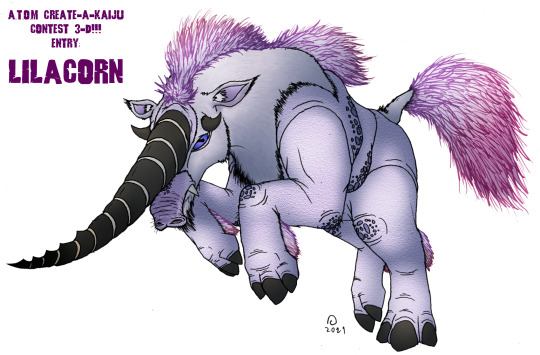

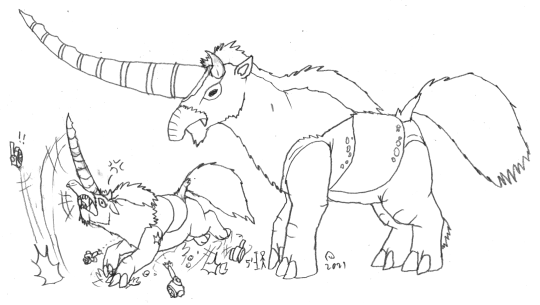
A.T.O.M. CREATE A KAIJU CONTEST 3-D!!! ENTRY: LILACORN
Aliases: Last of the Unicorns, Prancing Pony Princess, [various profanities in a Scottish accent]
Date (Re-)Discovered: June 21, 1962
Place of Origin:Scotland
Notable Stomping Grounds: Scottish Highlands, Echidna Island
Height: 80 feet at the withers
Length: 100 feet (excluding tail and horn)
Biology: First discovered in a lilac-forested, Yamaneon-rich Earth hollow beneath the Scottish highlands, Lilacorn is an elegant but bizarre herbivore whose horse-like appearance is only coincidental - many aspects of her anatomy from her three-toed hooves to her rhino-like dermal armor and from her stout tusks to her far more imposing cranial horns set her apart from most conventional equines. The general consensus is that she is most closely related to the much larger, bulkier mammal kaiju, Mastemuth, though her daintier appearance allows her to move at even greater speeds with enough open ground. More unusual still is that the concentration of Yamaneon within her tissues is higher than has been recorded in most other kaiju. This enables her to emit “pulses” of Yamaneon energy - producing an oddly pink glow in her mane, tail, eyes, and horn instead of green as in the normal substance - which can accelerate healing and growth in most other life forms and even neutralize a variety of posions, infectious bacteria, and other biological weapons.
Lilacorn cares little for this strange ability of hers, however, primarily relying on her trampling hooves and especially her enormous, incredibly strong, and lethally sharp central cranial horn, which is comprised of an unknown substance harder than any on record and capable of piercing through even reinforced Xeno-Titanium. Able to outpace most other kaiju before skewering them on that single terrifying horn, the lavender-colored pachyderm needs little more than the standard kaiju power set:
- Super strength
- An enhanced healing factor
- Immunity to radiation
- Healing Aura
Bio and Personality: The first appearance of Lilacorn occurred during the short-lived Beyonder invasion, wherein she charged in seemingly out of nowhere, viciously attacked the invading forces in Inverness, and mysteriously vanished after the few surviving Beyonders fled, not giving anyone a chance to study her. Her “official” discovery wouldn’t come until years later, shortly after a group of stranded hikers stumbled upon her hidden home, and then herself shortly after. Their celebration upon discovering a real, live “unicorn” - albeit much bigger than expected - turned into a panicked rout when she took their cheering for a threat display and pursued them out of the hollow, and then discovered what had become of the surface world she had once loved. Several brutal town-flattenings followed, followed by an attempt to seal her hollow off by caving in the entrance, only for her to emerge at the last moment and end up being shut out of her original home. Grief-stricken and enraged, she promptly and violently laid waste to the very same city she’d previously “rescued” before being finally detained after simply passing out from sheer exhaustion. The kaiju was swiftly deported to Echidna Island, where she has been regularly harassing the other residents ever since.
Lilacorn’s majestic appearance is deceptive - as gentle as she may seem from a distance, she is in fact one of the most bloodthirsty kaiju on the planet. No one can get close to her without being viciously attacked, and she will charge at anything alive that her acute senses detect, either to chase it off, trample it into the dirt, or simply gore it outright. A comparison can once again be made to Mastemuth in that she is similarly compelled to lord over other creatures, but because she lacks the size advantage of her distant cousin, it is her attitude that has to make up the difference, and she delivers it in plenty. Once riled into a frenzy, it’s all but impossible to get her to stop, and so she will continuously rampage for hours on end even long after what originally provoked her no longer presents a threat. Between her natural resilience and most other creatures not wanting to end up on the business end of a horn that can pierce almost anything, the majority of her rampages end when she finally runs out of stamina and simply keels over in a tired faint - and if she’s nursing a grudge against someone, she will simply track them down and continue her pursuit of them once she gets back up. Furthermore, the kaiju is far more intelligent than her savagery would suggest, and she is always keen on letting everyone know that fact. She will purposely sabotage capture equipment, turn environmental hazards against the opposition, and toy with opponents until they’re provoked into revealing a vulnerability which she can exploit with a single stab of her horn. Her distinctive “roar”, a raucous cackling mix of a rather donkey-like bray and a deep bellow, is often uttered when she’s successfully humiliated or impaled an adversary, and as it’s always accompanied by an almost smug expression, it is thought to be equivalent to laughter - a cruel, malevolent laugh befitting an equally cruel, malevolent bully.
It has been suggested that Lilacorn’s provocative behavior has a biological explanation, being derived from her species of origin presumably being territorial. Some other quirks of her behavior are a bit harder to explain, however. In particular, despite often trying to make kebabs of even fully-grown kaiju much weaker than her, she seems to shy away from the prospect of maiming creatures that were absolutely helpless when she found them, whether they’re too young to put up a fight or have already been injured by something else. If she sees another monster picking on a vulnerable target or even attacking them while they’re already down, she will always go for the attacker, especially if it was a child on the losing end - and if she senses that the creature she saved was injured, she will heal their wounds as well. That is as far as her empathy will go, however - once the deed is done, she will abandon her rescuee without a second thought. Lilacorn has nonetheless unwittingly “saved” baby kaiju enough times that they tend to regard her with gratitude and will try to follow her in a bid to repay her supposed kindness. While she wants nothing more to do with them most of the time, she seemingly can’t bring herself to hurt them and will simply leave when they approach, though she will reluctantly make an exception towards younglings who are persistent enough and will let them remain in her vicinity… even if she still absolutely refuses to let anyone get close enough to touch her.
The most likely reason for Lilacorn’s refusal to hurt children, ironically, is arguably the very same impetus for her hatred of almost all other creatures. Observers have sometimes reported the beast standing largely motionless on the coastlines of her new home, staring off at nothing in particular and occasionally emitting unearthly calls that sound almost mournful. It’s likely that even after all these eons, she still retains a herding instinct of some sort, and in fact may have once been the lead female of a herd of her kind prior to undergoing atomic fossilization, so it wouldn’t be surprising if she desired to be reunited with the herd she lost long ago. Unfortunately, since her kind is now completely extinct with the exception of herself, Lilacorn no longer has others like her for company. Her grief and anger over this may have thus transformed over the years into the nasty, spiteful demeanor she has today, believing that if she suffers from her loneliness, then everyone else should suffer, too. Whether she recognizes how flawed her logic is or if she’s simply using the stress of her being the last of her kind as an excuse to justify her savagery isn’t clear, but that doesn’t change the fact that her needlessly brutal conduct towards potential herd-mates who turn out to be too “different” cannot be condoned by most other kaiju, who will often attempt to stop her proactively before she hurts someone she shouldn’t have.
For all her ferocity, though, it isn’t impossible that Lilacorn secretly wants companionship once again - it’s just that her own personal faults are what end up discouraging it more often than not, and if she is aware of this fact, she chooses to purposely ignore it, having long since dismissed the possibility of befriending others as nonexistent for this reason. Nonetheless, the younger kaiju who know her seem to believe that she might be capable of genuine goodness more than she herself thinks, and that there is a non-zero chance of her mellowing out and becoming the leader of a new herd on Echidna Island. All she needs to do is open up her heart a little.
**********
In celebration of the release of the second volume of his fantastic e-novel series The Atomic Time of Monsters, @TyrantisTerror is hosting a third create-a-kaiju contest! I linked it at the start of this artist’s description, so go check out the rules post if you want to join! As for this entry, well… It’s #kaijune, right? And I’ve also wanted to contribute to #junicorn, right? Weeeeeeeell, what if I drew… a unicorn kaiju? Yessssss, it’s genius I say, absolute genius! Mwahaha! >:3
So basically, in the notes for the last create-a-kaiju contest entry I made, I said that my original entry was going to be a giant unicorn with rhino- and knight-like traits, which I rejected due to being too similar to Mastemuth, who is a member of the related “behemoth” clade which are basically very big weird thick-skinned prehistoric mammals… which was what that idea was too, actually. This time around, though, I decided to revisit the concept while leaning into precisely that similarity. I didn’t have any other ideas that resonated with me quite as well, and experimenting with a similar overall concept behind one of the “canon” designs, but taken in a completely different direction, was something I think a few other entries for the previous create-a-kaiju contests also did, so trying something similar with a less represented clade and design turned out to be worth exploring after all. So that’s exactly what I did here, though I did try to distinguish Lilacorn from Mastemuth to the best of my ability. Whether or not I succeeded of course is up for debate. ^^;
Compared to the previous entries I’ve made for these create-a-kaiju contests, I actually had a good idea of how Lilacorn would look from the get-go and managed to get the lineart done without too much trouble and almost no post-production revisions at all! It’s pretty funny to me because I actually did try to come up with a unicorn kaiju years ago only to scrap it because it looked too similar to someone from a certain popular new-tens cartoon, and instead came up with a design inspired by giraffes and deer rather than horses. For this design, though, I decided to start with Pliny’s account of the unicorn as having a deer’s head, horse’s body, elephant’s feet, and boar’s tail, and then build from there until I had something more prehistoric-looking to better fit A.T.O.M.’s 50’s sci-fi aesthetic - though I did also give her a short trunk to distinguish her face from Mastemuth’s, like older depictions of Macrauchenia as well as saiga antelope and tapirs. Other contributing influences include indricotheres, Elasmotherium, wildebeest, a bit of bison, medieval unicorn tapestries, Amalthea from The Last Unicorn, the Galarian Ponyta line, a touch of Shadowfax, and of course a wee smidge of the aforementioned popular new-tens cartoon. I did have to revise the color scheme somewhat because originally she had a rainbow-colored mane a la Starlite from Rainbow Brite but I figured that’d be too ridiculous and implausible, so I ended up giving her a palette more akin to a lightened, desaturated reference to Twilight Sparkle (sans cutie mark of course lol) while also homaging how Amalthea is introduced in her novel of origin living in a “lilac forest”, which is incidentally the source of both her name and the, well, lilac forest she was found in. (The date of her discovery, btw, alludes to when the author of The Last Unicorn novel, Peter S. Beagle, was inspired to write it.)
As for her personality… yep, she’s basically a “bad girl” archetype =P. I was thinking of Harley Quinn’s depiction in the Birds of Prey movie specifically with respect to that but her character can be taken as a nod to any example of the trope. I’m not sure if a brutal badass female thug who starts off as a villain but has a hidden heart of gold has been represented yet as a kaiju personality in A.T.O.M. proper (though one could argue that Tyranta fits that mold, she was never an antagonist to begin with), but the old accounts of unicorns as being such wild, violent creatures coupled with how they were only pacified by virgins (albeit with accounts of that varying from allegorical to downright skeevy) meant that it was only fitting to characterize her as a fierce, harsh-natured bully who eventually softens up and learns goodness but never loses her prideful ferocity. If I had a penny for every time I’ve submitted an entry for the create-a-kaiju contests for which the personality was that of a villain (at first) but with sympathetic aspects, I’d have two pennies - not a lot, but it’s funny that I’ve done that twice now. XD
Regardless, best of luck to all entrants! And if you want to check out The Atomic Time of Monsters, both volumes are available for purchase on Amazon and Kindle (the latter of which was what I went with to save money). Go check them both out - these are truly stellar pieces of work!
The Atomic Time of Monstersand all related concepts © William Cope a.k.a. TyrantisTerror
A fellow monster artist of mine, @tyrantisterror, drew this lovely girl for me for just $5, a third of the usual $15 thanks to an ongoing sale - she’s part of an upcoming new project of mine that I’m largely keeping under wraps for now. But I can at least provide the gist of it here: Humankind’s subconscious is the source of a set of alternate dimensions a la Persona (with a smidge of @carnivorecreations’ defunct ID project; I got his approval to use the general concept as a basis for the worldbuilding of this one, don’t worry!). Everybody has a corresponding kaiju or monster in the mindscapes created from their deepest subconscious natures, of a variety of different types, but while people often become aware of their giant counterparts at some point in their lives, they can never really connect with them beyond dream-world interaction… or so everyone thinks. ;P
This is Guandon, the main character’s kaiju equivalent, a Prehistoric-type retrosaur - an herbivorous one, since I figured that plant-eating dinosaurs/retrosaurs need more love from a monster designer standpoint, ornithopods especially. The choice behind selecting a kind of animal everyone else sees as cannon fodder in dinosaur media as a design basis rather than, say, the bigger-name stars like T. rex or Stegosaurus is because the mindscape kaiju are based not on what their creators wish to be, but what they are truly like, and in the MC’s case this means being easily dismissed despite being capable in his own right. Guandon herself is a conglomerate of virtually every depiction if Iguanodon from the earliest to the most recent, with additional elements of actual iguanas (since the first depiction of Iguanodon was literally a giant iguana with a nose horn), obsolete aquatic hadrosaurs, and those iguana-Dimetrodon slurpasaurs from Journey to the Center of the Earth (1960). She’s rather high-strung and easily upset, but also very caring to those she gets to know personally. Also I’m getting a slight rocker girl vibe from her now and I love it, so I might play that up when I draw her official artwork - and I gotta say, TT did a wonderful job with her as it is!
I’ll start cranking out the details regarding this new project and several others after I take care of urgent IRL business, but in the meantime, feel free to stop by TT’s $5 sketch sale (assuming it’s still ongoing). And while I’m at it, allow me to shill his kaiju novel as well, ATOM Volume 1. His artwork, worldbuilding, and writing are absolutely amazing!
https://www.amazon.com/gp/product/1070441503/ref=dbs_a_def_rwt_bibl_vppi_i0
Post link
@tyrantisterror Revenge of the ATOM Create-A-Kaiju Contest Entry: GNOMORAN
- Date Discovered: December 1, 1956
- Aliases:The Beast of Emain Ablach, The Mutant Mole Monster, The Elder Gnome, Sciúirse Talún (”Scourge of Earth” in Irish)
- Place of Origin: The Emain Ablach Earth Hollow
- Notable Stomping Grounds: The Emain Ablach Earth Hollow; most of the coastal regions of Ireland and northwestern Europe; possible sightings in and around Scandinavia and the European Arctic circle
- Height: 50 feet
- Length: 75 feet
Description and Biology:
“Unsightly” is a word that describes Gnomoran quite well. Descended from a deviant prehistoric species of talpid mole that found its way to Ireland prior to the last ice age surrounding the island country with seawater, the fossorial creature has changed quite significantly compared to its ancestors, though its overall build - a cylindrical body, powerful burrowing clawed forepaws, velvety fur that doesn’t flow in any major direction, sharp insect-catching teeth, and an acute sense of smell - has been retained due to being perfectly suited for its ecological role. However, its limb proportions are quite different from a typical mole, in that they are somewhat longer proportionally, though the back limbs are still shorter than the forelimbs. Likewise, its scaly, rat-like tail has become thicker and longer, more like that of a lizard, and though largely quadrupedal, it can rear up and even walk in a tripodal stance if it needs to either better sense its environment when above-ground or bring its weaponry to bear in combat, though it still looks somewhat hunched when on two legs. The forelimbs are burly and bear-like with hairless, scaly paws and five enormous, sturdy, relatively straight claws almost like those of a ground sloth on each hand, and the enlarged digit-like bone on each wrist has also developed into a curved, bladed spike for use as a weapon. Its plantigrade back feet are also scaly but with much shorter, more curved claws for traction. Most significantly, however, its head barely resembles that of its ancestors from the outside. Its medium-length snout and sharp-toothed jaws seem to have been remain largely unchanged in skeletal structure, and its light red eyes are small and insignificant, but the similarities end there. The front of the forehead bulges upwards and is heavily reinforced, because it serves as the base for a massive, straight, conical horn, spiraled like a narwhal’s tusk, that points straight ahead and helps Gnomoran bore through the earth along with its clawed paws; the snout and mouth poke out underneath it like the mouth of a goblin shark. The snout and chin themselves are covered in long hair like a mustache and beard, and on the very end of the snout, the nose itself has about a dozen flexible fleshy feelers like catfish barbels which it uses to sense its environment. It is the top of the head that is most notable: it is entirely hairless, and the base of the horn, the scalp, and the sides of the face are all covered in wart-like tumors and skin eruptions of varying sizes. Its teeth are typical of a mole’s, which resemble those of a carnivoran (including canine fangs and carnassials) rather than those of the only distantly related rodents; however, the front-most incisors are elongated to the point where they resemble rodent teeth, and some of its teeth are also missing or even broken from countless fights.
The monster’s scraggly, unkempt fur is a uniform shade of pale bluish gray with silvery streaks here and there, along with cream-colored facial hair uncannily resembling the mustache and beard of a garden gnome. Its paws, tail, and the skin and tumors on its face are a pale red, and its claws, wrist spikes, and horn are reinforced by iron and are thus a vivid red-orange in color.
Aside from enhanced brute strength and burrowing capabilities, Gnomoran seems to be an accomplished swimmer, and has been seen paddling through the coastal seas off of northwestern Europe in a breaststroke-like fashion, moving with surprising speed to surprise watercraft and tunneling straight into the ground from the water, though its agility in the water obviously pales in comparison to more dedicated swimmers. Like some other species of mole, it also has venomous saliva which causes temporary paralysis, once used to store prey in “larders” for lean times, but also just as effective in combat. Most critically, however, the tumors on the mole-beast’s head, which seem to emerge as often as they are ruptured, contain a grisly byproduct of its radiation-metabolizing biology, a corrosive grease of sorts formed from the juices of its runaway regenerative processes. If an opponent foolishly attacks its face, the fluid released by the punctured pustules will more often than not begin to flow down its horn, making its goring attacks even deadlier. It may even pop its own pustules using its front claws and wrist blades to coat them in these caustic juices, and doesn’t care if its skin and fur are also eaten away in the process - it can simply regenerate afterward. In fact, its regenerative ability is especially developed among kaiju of its scale, recovering from injuries in a much shorter span of time than normal and bouncing back from wounds that would kill a more typical kaiju, making it that much more difficult to kill and all the more frustrating for it.
Gnomoran thus adds a few insidious abilities to the standard kaiju set:
- Super strength
- An extremely enhanced healing factor
- Immunity to radiation
- Paralytic venomous bite
- Caustic Pus
History:
The ancestors of Gnomoran seem to have gone extinct towards the end of the last ice age, when a gradually warming climate and increased humidity deprived them of the drier, cooler soils that they favored, as well as the cold-tolerant invertebrates that made up much of their diet. The last known population seems to have held out on the Isle of Man before fading out some 10,000 years ago, but not before some of them presumably tunneled into a Yamaneon-rich earth hollow beneath the island which wouldn’t be discovered until much more recently. The hollow was found by a team of Irish geologists in late 1956 and, accordingly, named after an otherworldly location in Irish myth associated with the Isle of Man among other isles in proximity to the region. The hollow itself was not the only discovery they made that day, however - Gnomoran’s instinctive prey drive, largely unchanged despite no longer requiring sustenance, regarded the scientists as prey and incited it to pursue them out of the hollow, killing several of them in the process. Escaping to the outside world, it made its way to the nearest body of land it could find and laid waste to the town of Newcastle, Irleand before military resistance sent it back into the sea. The creature then ventured northwards, attacking any coastal settlements and ships unlucky enough to be in its path, before finally tunneling into the Isle of Arran and disappearing from the public eye.
Several months later, the city of Glasgow, already in economic decline and rapid de-industrialization at the time, was in for a nasty surprise when an enormous red horn burst out of the streets and Gnomoran plunged into the heart of the city, ransacking everything in its way and devouring dozens of homeless, destitute people as it went. It was only thanks to British military aid that the creature was driven away from the better-off parts of the city, but not before a significant portion of the infamous Glasgow slums had been reduced to rubble. Its rampage finally ended when it attempted to escape into the River Clyde only to take a torpedo to the mouth, critically wounding it, whereupon it was promptly captured for transportation to the newly established Siberian Monster Zone. Sometime during its transportation, however, the ship containing it mysteriously sank, with all on board reported dead or missing - Gnomoran itself being among the latter. Eyewitness reports of the creature doing battle with other kaiju across northwestern Europe came up several times throughout the following year, complete with documented evidence of its presence, but no accounts of the creature invading major cities have been recorded since its sacking of Glasgow. Plans upon detainment are to deposit it in the Siberian Monster Zone as originally intended, but actually finding it is another story - the randomness of the mole-beast’s meanderings means its current whereabouts are as yet unknown.
Personality:
As a result of Yamaneon exposure and atomic fossilization, Gnomoran’s regenerative factor seems to be quite enhanced even by kaiju standards. Combined with its toxic secretions, this makes it an unexpected threat and a daunting foe to face despite its size and seeming fraility, and as has been gleaned from personal accounts by many survivors of its attacks, the mutant talpid seems to be aware of this. It is chaotic and unpredictable, retreating one moment and barreling at opponents horn-first the next, and its ability to strike from unexpected angles and disappear without much fanfare has made for infuriating and often traumatizing experiences for both the various European militaries and enemy kaiju it’s encountered. The Pleistocene relic also has a sadistic, vindictive streak, exacting disproportionate retaliation and brutally mauling other life forms on its scale even if they only harmed it by accident, to say nothing of toying with smaller things like humans and vehicles like a child prone to breaking playthings on a whim. It also cares little for self-preservation due to its healing factor and is highly aggressive to beings that upset it as a result, having the audacity to fend off kaiju several times its size. The mole-beast is infamous for picking fights with others without rhyme or reason, attacking even when its remaining instincts aren’t informing it that it is hungry.
Reportedly, kaiju who weren’t as violent as Gnomoran itself have learned to simply leave rather than engage the creature whenever it drew near since its emergence, presumably having witnessed the bloody aftermath of its fights during their own travels. Many in fact preferred not to draw its attention if possible, lest it decide to chase them down and exercise its self-perceived entitlement to chronic and sustained cruelty. Strangely enough, however, more than half of the sightings of the creature since the Glasgow incident involved the provocation of an even bigger, more powerful beast, with Gnomoran sustaining severe or even mortal injury upon disengaging. Some have speculated that it may even have enjoyed being mangled each time, explaining why it incited such fights so often. The kaiju has even been known to quite happily hurl itself right into dangerous territory such as hazardous environments and obstacles, fights where it is severely outmatched, or even disasters it has bought upon itself, further validating these claims.
Humanity fares even worse against the monster, for obvious reasons, and military efforts have thus far only raised its ire ever more greatly. Vehicles and groups of people attract its predatory instincts, as its brain is hard-wired to view smaller creatures as prey, especially in groups. Whenever it has made landfall, it seems to have made a beeline for coastal villages and suburbs. Its experience in Glasgow seems to have taught it not to venture into major cities, however, which is just as well, since the collateral caused by both it and military actions against it would be too great if it decided to attempt another municipal raid. Although it doesn’t even need organic sustenance anymore, it is still compelled to consume large amounts of small prey due to its mentality remaining the same as that of a much smaller creature. This compels it to seek populated regions, forcing military retaliation and fueling its contempt for humanity in a vicious cycle. This is why many north-European coastal nations have since made evacuating rural areas their first priority in the event of its appearance, only employing martial resistance if left with no other choice.
As elusive as the elderly creature is physically, remnants of Gnomoran’s presence, typically fur, pus, blood, and even bits of flesh, have been recovered from almost every site where conflict between it and other kaiju has been noted. Recent biological analysis of these remains has revealed that its abnormality and instability seem to extend beyond the tumors on its head - its small size and sadomasochistic aggression have resulted in it sustaining many, many injuries, including numerous internal ones due to how often it has been crushed or its vitals damaged. Its extremely high healing factor fast-tracking the repair of these injuries seems to have resulted in tumors and pustules overcrowding any wound it has received, and the extent of the cycle of damage may go beyond even that.
Many scientific reports related to Gnomoran have turned up one distressing commonality: living cell matter associated with the mole-beast has been known to spontaneously develop into tumors even in containment or otherwise in isolation of the source, and some have speculated that the monster’s own inner anatomy constantly experiences the same issue, with every muscle, organ, and neuron growing, eroding, and re-growing at an explosive rate. Combining this with accounts of its cries constantly sounding as though it were severely hurt, along with its habit of intentionally blundering into hazardous situations, a few analysts have even speculated that this aspect of its biology causes the kaiju immense pain on a constant basis, which may explain why the creature is so pugnacious and prone to violence and self-harm: its own runaway growth may be railroading it into waging war with others so that its own constantly growing flesh can be broken, battered, and ripped away from itself before it overtakes its critical anatomy, condemning it to an agonizing fate far worse than death.
In summation, it seems that Gnomoran is a beast that has vastly overstayed its welcome, both on Earth and compared to the expected lifespan of its kind, and the inadvertent prolonging of its mortal coil has thrown some catastrophic side-effects into the mix. While its behavior may be an indicator that it is vaguely aware of this notion, its instincts have sadly locked it into the violent, self-destructive path it has followed for far too long. The mole-beast is indeed a monster - but not an entirely unsympathetic one.
Notes:
Whew! This guy, right here, was a true exercise in flexing my creative muscles, and took a number of attempts design-wise to get right, but I believe I pulled through in the end. :)
One of the gaps I noticed in both ATOM and the real life giant monster filmography worldwide was that Europe seems to have been rather neglected in the atomic age, in spite of having a rich source of mythical creatures that could’ve been adapted to the era in some fashion (hell, IIRC only Reptilicus borrowed from that, being a medieval dragon and such). There also weren’t as many Trogcestor kaiju as there were retrosaurs, so in the wake of how successful one of my last ATOM contest entries was, I needed something both mythical and prehistoric-looking. My original plan was in fact a gigantic monstrous unicorn with a rhinoceros-esque flair and a theme like a jousting knight, but then I remembered that a Behemoth already exists as a kaiju in the ATOM canon, and what with unicorns being closely related to behemoths in the fantasy ‘verse ATOM shares its world with, I sadly had to scrap it. Luckily, another concept I had planned fit much better, and that was refined into Gnomoran here.
This bad boy is, in fact, related to the ancestors of TT’s dwarves (including gnomes), which are basically weird sapient moles, so I decided to pitch to myself the idea of a freaking lawn gnome as a kaiju - which would be a gloriously ridiculous idea without the context - and see if I could make it work. I ended up with this gigantic monstrous prehistoric “unicorn mole” with a lance-like horn on its head referencing the famous hat, with a touch of The Mole People B-movie mixed in (note: the date of discovery is the same as the real-world release date of The Mole People). The overall design combines said Mole People not only with more accurate anatomy from talpid and star-nosed moles, but also flourishes from Guiron, Gabara, Baragon, and even a touch of Knifehead for the snout, though the facial tumors were entirely my invention. The history meanwhile is more akin to The Giant Behemoth (which was released just over two years after The Mole People, incidentally), the titular beast of which was said to be suffering radiation sickness but didn’t have a design indicating as such. I decided to swap out radiation for cancer for thematic reasons, and had Gnomoran live through his ordeal and escape to live and fight another day. His name, by the way, is a portmonteau of “Gnome” and “Formorian”, a race of vicious subterranean dwarves from Celtic lore, which also explains his presence in an Irish territory - the Isle of Man is one of the real locations associated with the mythical realm of Emain Ablach, for which Gnomoran’s place of birth is named.
So why does he have “everywhere-cancer”, you may ask? Well, that ties into the theme I had in mind. I noticed that there were plenty of “good guy” monsters in the world of ATOM, and even a lot of the antagonists redeem themselves to some extent. But has there been anybody designed as a “hate sink” of sorts, someone despicable enough that nobody wants them around? I wanted to come up with one of those since I’d done only one antagonistic kaiju in the previous ATOM contest compared to three relatively decent ones, but I obviously didn’t want to violate the ruling that the villain has to have at least one virtuous characteristic, though, so I ended up making him a tragic villain instead, and themed him around the health complications of old age and the perennial issue in fantasy fiction of prolonging one’s lifespan through unnatural means. The inspiration for this was the loss of my family’s two dogs earlier this year, and in the case of the latter I actually had the misfortune to witness her waste away due to health complications at her age. “Old-ness” is an unavoidable thing that is only comprehensible to those who are already old, and hated by everyone else in some way or another. Who would want to see the loss of their youth and vitality while becoming elderly and senile, after all? There are a lot of things to enjoy about the autumn years of your life, sure, but the sad truth is that when you’re old, you’re more vulnerable to disease, and cancer in particular. The elder of our dogs lost his life to spleen cancer, in fact, which has weighed heavily on me since then. Thus, I gave Gnomoran a face encrusted by tumors, while also hinting at his entire body from snout to tail also being full to bursting with more of them. Then I realized that a certain merc with a mouth from the X-Men comics has the same issue, and then everything fell into place regarding his personality. Deadpool would, after all, be a completely unlikeable asshole without all that snark! So Gnomoran thus became this crazed, elderly maniac with all of Deadpool’s psychotic problems and none of the fourth-wall-breaking comedic charm, thus bringing the issues Gnomoran has to the spotlight: he’s old and outdated, constantly and gravely ill, and hurting all over, which has made him totally miserable, but unfortunately, his coping mechanism is not snide meta humor but rather attacking anything that crosses him in the hopes of alleviating the constant overgrowth of his own body. This may have even come about because his first interaction with humanity was violent by necessity, what with him trying to eat people and all. Hence, he’s a crotchety old geezer who WILL cut a bitch when given the chance - an opposite to the way more mellow albeit territorial Julkath, if anything - but he at least isn’t violent without reason. The fact that many insectivorous small mammals really are almost as aggressive IRL and have stupidly short lifespans because reasons was the icing on the cake. Poor guy outlasted his entire species, no wonder he’s mad about it. :P
All in all, I’m happy with this crusty old fart and his overall concept, and hopefully it’ll be worthy of its place alongside the other entrants into this second ATOM Create-A-Kaiju Contest. Best of luck to everyone else who’s submitted, and of course, may the best monster win! :D
Atomic Time of Monsters universe © @tyrantisterror
Post link
I swear, the “MAYBE NOT” at the end kills me every single time.


